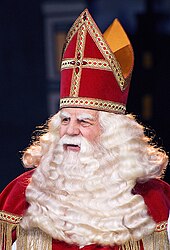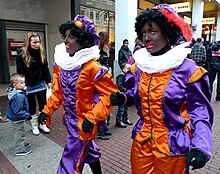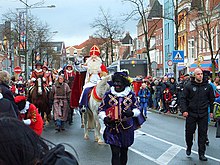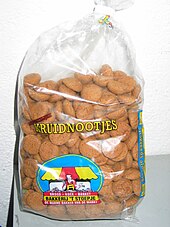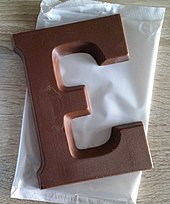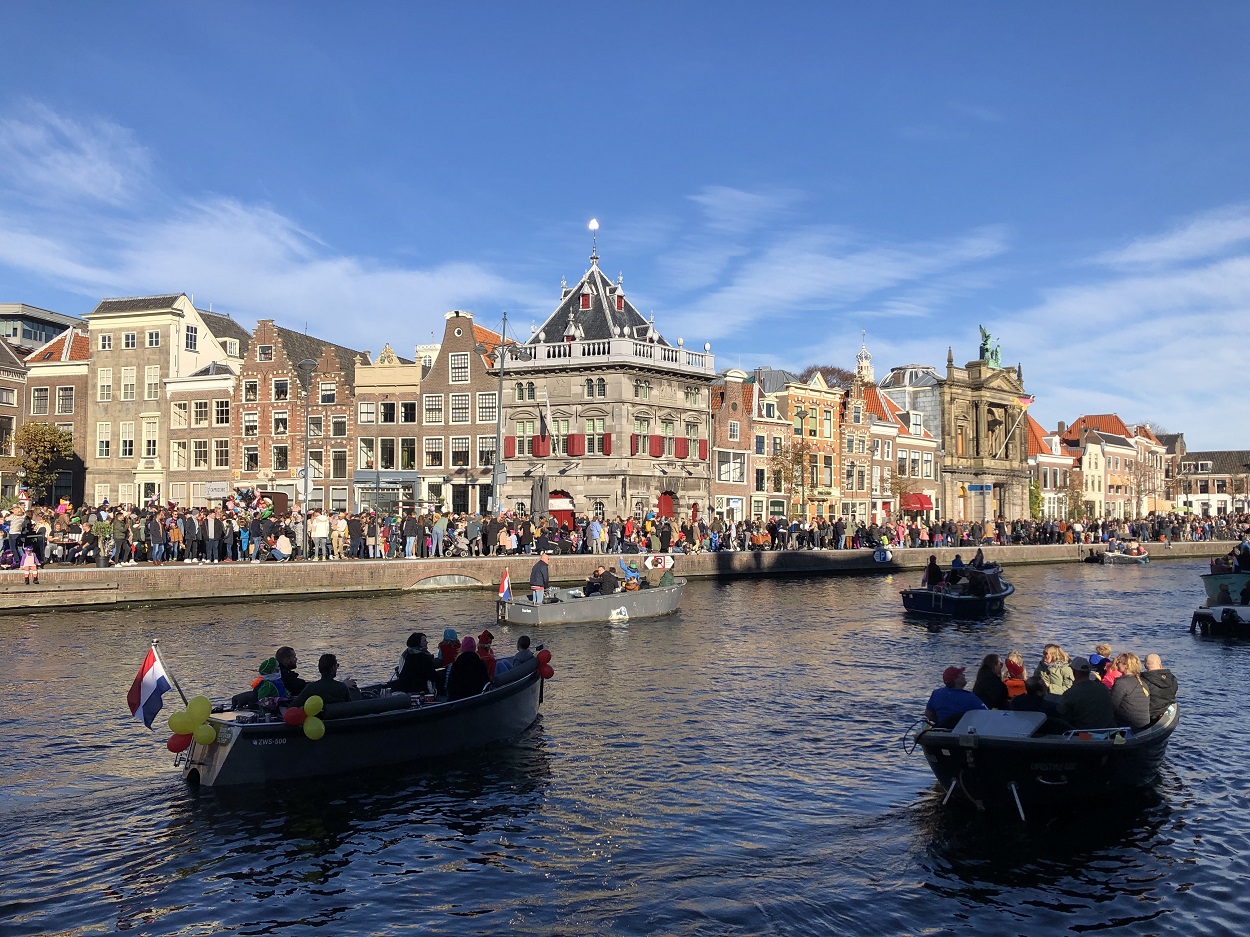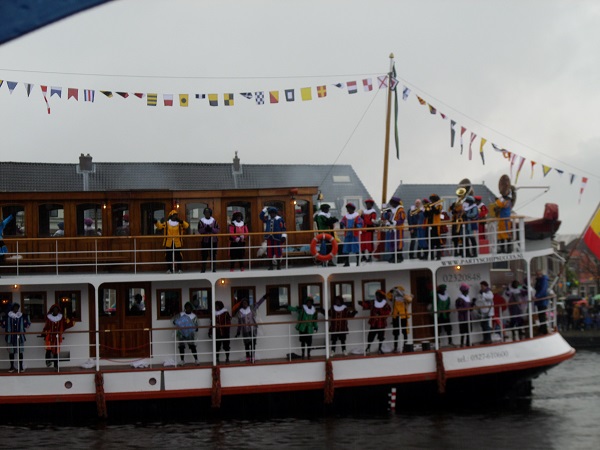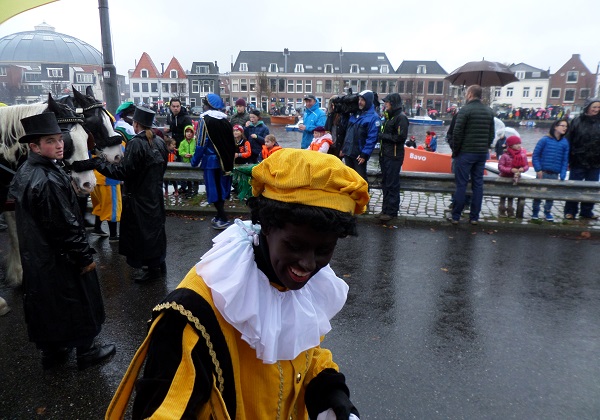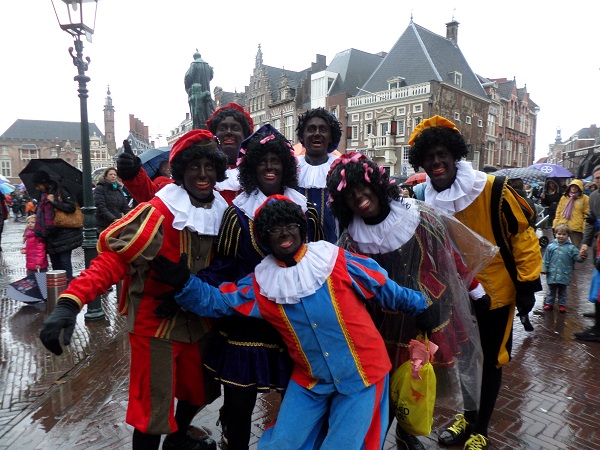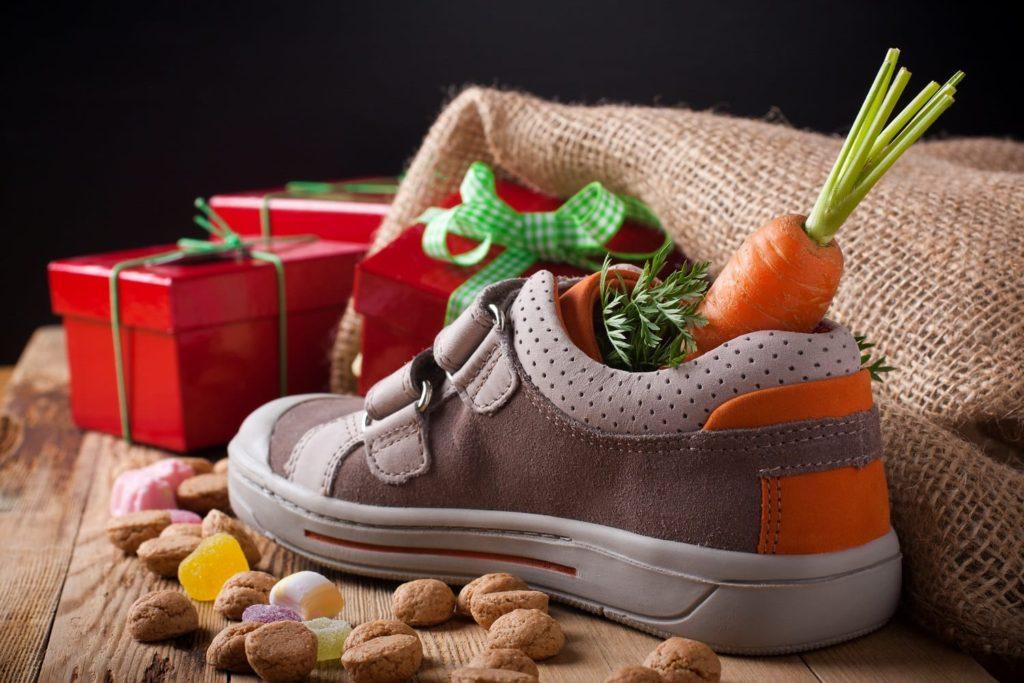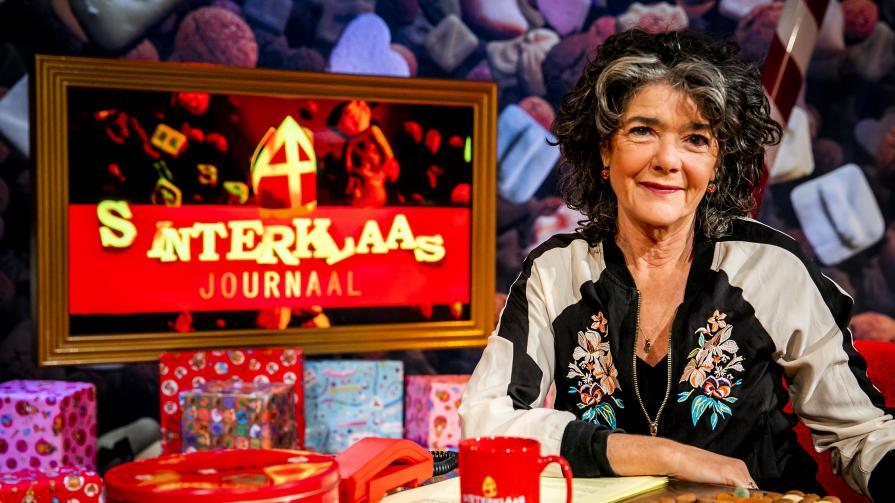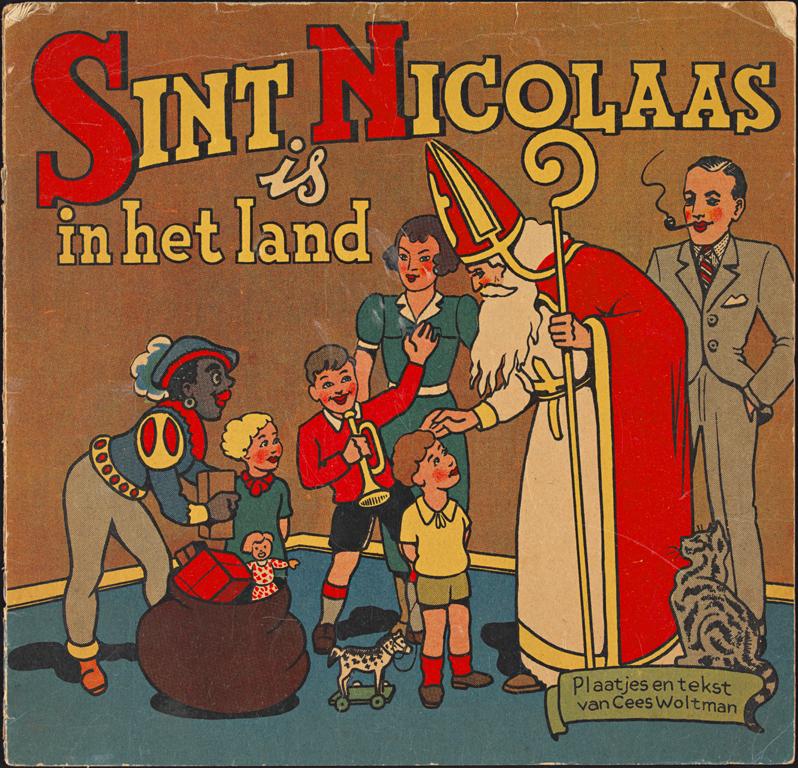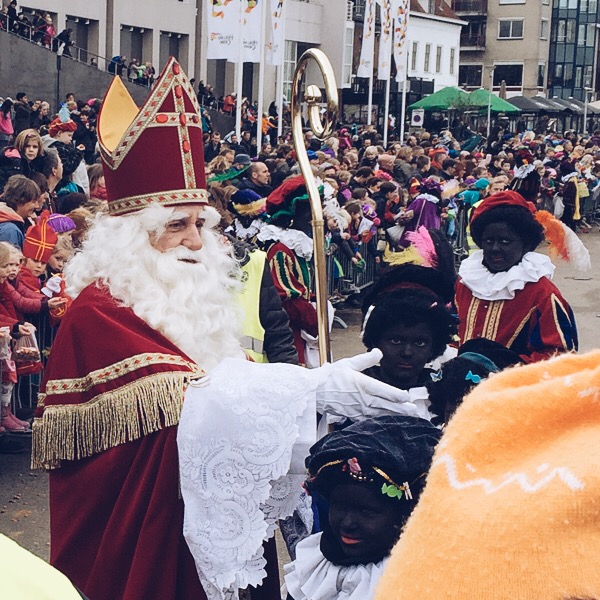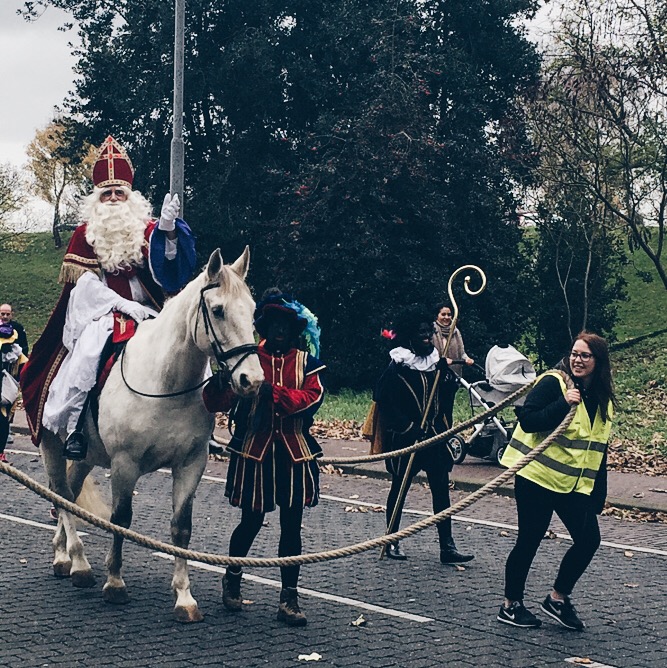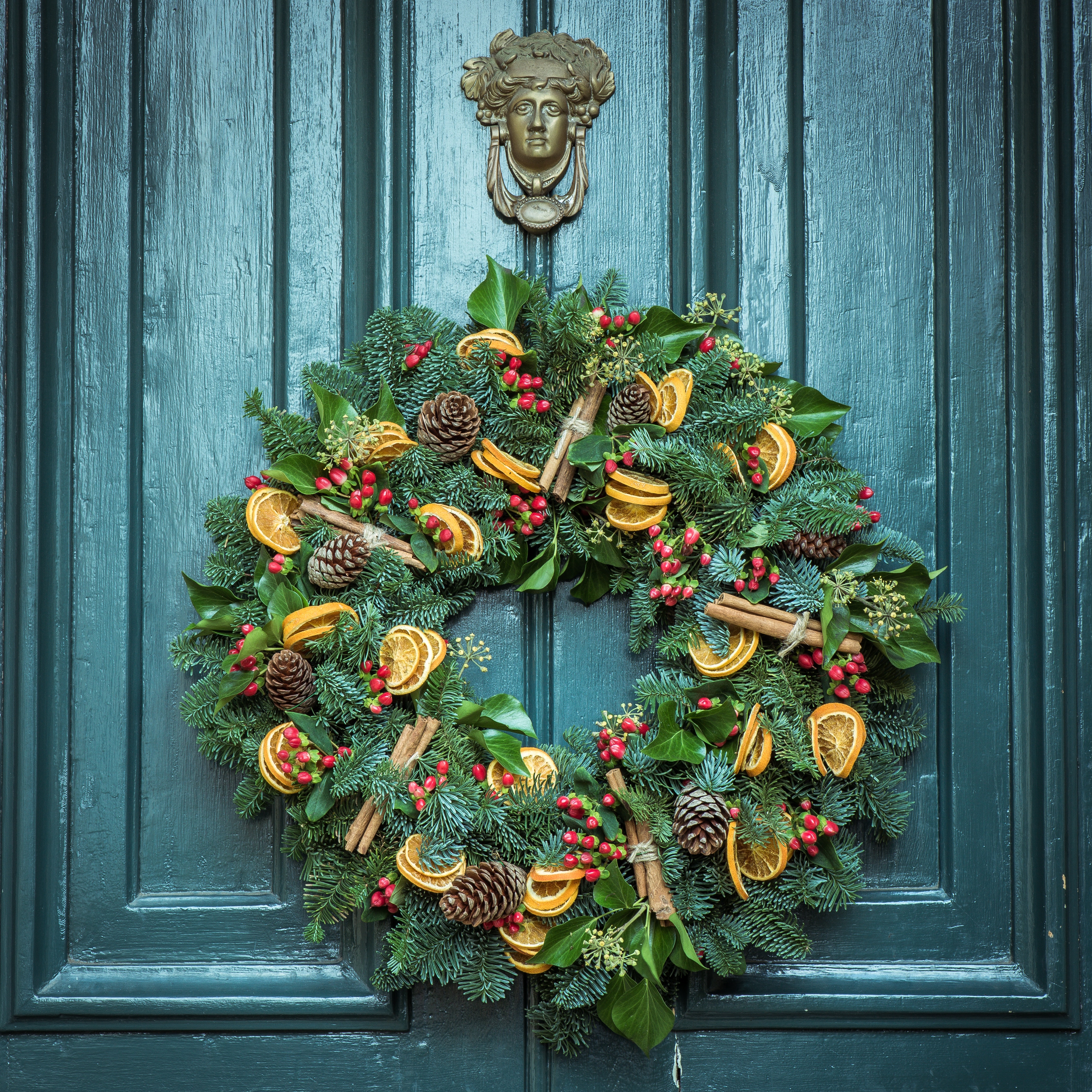Sinterklaas (Dutch: [ˌsɪntərˈklaːs]) or Sint-Nicolaas (Dutch: [sɪnt ˈnikoːlaːs] (listen)) is a legendary figure based on Saint Nicholas, patron saint of children. Other Dutch names for the figure include De Sint («The Saint»), De Goede Sint («The Good Saint») and De Goedheiligman («The Good Holy Man»). Many descendants and cognates of «Sinterklaas» or «Saint Nicholas» in other languages are also used in the Low Countries, nearby regions, and former Dutch colonies.[note 1]
The feast of Sinterklaas celebrates the name day of Saint Nicholas on 6 December. The feast is celebrated annually with the giving of gifts on St. Nicholas’ Eve (5 December) in the Netherlands and on the morning of 6 December, Saint Nicholas Day, Belgium, Luxembourg, western Germany, northern France (French Flanders, Lorraine, Alsace and Artois), and Hungary. The tradition is also celebrated in some territories of the former Dutch Empire, including Aruba.
Sinterklaas is one of the sources of the popular Christmas icon of Santa Claus.[1][2]
Figures[edit]
Sinterklaas[edit]
Sinterklaas is based on the historical figure of Saint Nicholas (270–343), a Greek bishop of Myra in present-day Turkey. He is depicted as an elderly, stately and serious man with white hair and a long, full beard. He wears a long red cape or chasuble over a traditional white bishop’s alb and a sometimes-red stole, dons a red mitre and ruby ring, and holds a gold-coloured crosier, a long ceremonial shepherd’s staff with a fancy curled top.[3]
He traditionally rides a white horse. In the Netherlands, the last horse was called Amerigo, but he was «pensioned» (i.e., died) in 2019 and replaced with a new horse called Ozosnel («oh so fast»), after a passage in a well-known Sinterklaas song.[4] In Belgium, the horse is named Slecht weer vandaag, meaning «bad weather today»[5] or Mooi weer vandaag («nice weather today»).[6]
Sinterklaas carries a big, red book which records whether each child has been good or naughty in the past year.[7]
Zwarte Piet[edit]
Sinterklaas is assisted by Zwarte Piet («Black Pete»), a helper dressed in Moorish attire and in blackface. Zwarte Piet first appeared in print as the nameless servant of Saint Nicholas in Sint-Nikolaas en zijn knecht («St. Nicholas and His Servant»), published in 1850 by Amsterdam schoolteacher Jan Schenkman; however, the tradition appears to date back at least as far as the early 19th century.[8] Zwarte Piet’s colourful dress is based on 16th-century noble attire, with a ruff (lace collar) and a feathered cap. He is typically depicted carrying a bag which contains candy for the children, which he tosses around, a tradition supposedly originating in the story of Saint Nicholas saving three young girls from prostitution by tossing golden coins through their window at night to pay their dowries.
Traditionally, he would also carry a birch rod (Dutch: roe), a chimney sweep’s broom made of willow branches, used to spank children who had been naughty. Some of the older Sinterklaas songs make mention of naughty children being put in Zwarte Piet’s bag and being taken back to Spain. This part of the legend refers to the times that the Moors raided the European coasts, and as far as Iceland, to abduct the local people into slavery. This quality can be found in other companions of Saint Nicholas such as Krampus and Père Fouettard.[9] In modern versions of the Sinterklaas feast, however, Zwarte Piet no longer carries the roe and children are no longer told that they will be taken back to Spain in Zwarte Piet’s bag if they have been naughty.
Over the years many stories have been added, and Zwarte Piet has developed into a valuable assistant to the absent-minded saint. In modern adaptations for television, Sinterklaas has developed a Zwarte Piet for every function, such as a Head Piet (Hoofdpiet), a Navigation Piet (Wegwijspiet) to navigate the steamboat from Spain to the Netherlands, a Presents Piet (Pakjespiet) to wrap all the gifts, and Acrobatic Piet to climb roofs and chimneys.[10] Traditionally Zwarte Piet’s face is said to be black because he is a Moor from Spain.[11] Today, some children are told that his face is blackened with soot because he has to climb through chimneys to deliver gifts for Sinterklaas.
Since the 2010s, the traditions surrounding the holiday of Sinterklaas have been the subject of a growing number of editorials, debates, documentaries, protests and even violent clashes at festivals.[12] Some large cities and television channels now only display Zwarte Piet characters with some soot smudges on the face rather than full blackface, so-called roetveegpieten («soot-smudge Petes») or schoorsteenpieten («chimney Petes»).[13][14]
In a 2013 survey, 92 per cent of the Dutch public did not perceive Zwarte Piet as racist or associate him with slavery, and 91 per cent were opposed to altering the character’s appearance.[15] In a similar survey in 2018, between 80 and 88 per cent of the Dutch public did not perceive Zwarte Piet as racist, and between 41 and 54 per cent were happy with the character’s modernised appearance (a mix of roetveegpieten and blackface).[16][17]
A June 2020 survey saw a drop in support for leaving the character’s appearance unaltered: 47 per cent of those surveyed supported the traditional appearance, compared to 71 per cent in a similar survey held in November 2019.[18] Prime Minister Mark Rutte stated in a parliamentary debate on 5 June 2020 that he had changed his opinion on the issue and now has more understanding for people who consider the character’s appearance to be racist.[19]
Celebration[edit]
Arrival from Spain[edit]
Sinterklaas and his Zwarte Piet helpers arriving by steamboat from Spain
The festivities traditionally begin each year in mid-November (the first Saturday after 11 November), when Sinterklaas «arrives» by a steamboat at a designated seaside town, supposedly from Spain. In the Netherlands this takes place in a different port each year, whereas in Belgium it always takes place in the city of Antwerp. The steamboat anchors, then Sinterklaas disembarks and parades through the streets on his horse, welcomed by children cheering and singing traditional Sinterklaas songs.[20] His Zwarte Piet assistants throw candy and small, round, gingerbread-like cookies, either kruidnoten or pepernoten, into the crowd. The event is broadcast live on national television in the Netherlands and Belgium.
Following this national arrival, other towns celebrate their own intocht van Sinterklaas (arrival of Sinterklaas). Local arrivals usually take place later on the same Saturday of the national arrival, the next day (Sunday), or one weekend after the national arrival. In places a boat cannot reach, Sinterklaas arrives by train, horse, horse-drawn carriage or even a fire truck.
Sinterklaas is said to come from Spain, possibly because in 1087, half of Saint Nicholas’ relics were transported to the Italian city of Bari, which later formed part of the Spanish Kingdom of Naples. Others suggest that mandarin oranges, traditionally gifts associated with St. Nicholas, led to the misconception that he must have been from Spain. This theory is backed by a Dutch poem documented in 1810 in New York and provided with an English translation:[21][22]
Sinterklaas, goedheiligman! |
Saint Nicholas, good holy man! |
The text presented here comes from a pamphlet that John Pintard released in New York in 1810. It is the earliest source mentioning Spain in connection to Sinterklaas. Pintard wanted St. Nicholas to become patron saint of New York and hoped to establish a Sinterklaas tradition. Apparently he got help from the Dutch community in New York, that provided him with the original Dutch Sinterklaas poem. Strictly speaking, the poem does not state that Sinterklaas comes from Spain, but that he needs to go to Spain to pick up the oranges and pomegranates. So the link between Sinterklaas and Spain goes through the oranges, a much appreciated treat in the 19th century. Later the connection with the oranges got lost, and Spain became his home.
Period leading up to Saint Nicholas’ Eve[edit]
In the weeks between his arrival and 5 December, Sinterklaas visits schools, hospitals, and shopping centers. He is said to ride his white-grey horse over the rooftops at night, delivering gifts through the chimney to the well-behaved children. Traditionally, naughty children risked being caught by Black Pete, who carried a jute bag and willow cane for that purpose.[23]
Before going to bed, children each leave a single shoe next to the fireplace chimney of the coal-fired stove or fireplace (or in modern times close to the central heating radiator, or a door). They leave the shoe with a carrot or some hay in it and a bowl of water nearby «for Sinterklaas’ horse», and the children sing a Sinterklaas song. The next day they find some candy or a small present in their shoes.
Typical Sinterklaas treats traditionally include mandarin oranges, pepernoten, speculaas (sometimes filled with almond paste), banketletter (pastry filled with almond paste) or a chocolate letter (the first letter of the child’s name made out of chocolate), chocolate coins, suikerbeest (animal-shaped figures made of sugary confection), and marzipan figures. Newer treats include gingerbread biscuits or and a figurine of Sinterklaas made of chocolate and wrapped in coloured aluminium foil.
Saint Nicholas’ Eve and Saint Nicholas’ Day[edit]
In the Netherlands, Saint Nicholas’ Eve, 5 December, became the chief occasion for gift-giving during the winter holiday season. The evening is called Sinterklaasavond («Sinterklaas evening») or Pakjesavond («gifts evening», or literally «packages evening»).
On the evening of 5 December, parents, family, friends or acquaintances pretend to act on behalf of «Sinterklaas», or his helpers, and fool the children into thinking that «Sinterklaas» has really given them presents. This may be done through a note that is «found», explaining where the presents are hidden, as though Zwarte Piet visited them and left a burlap sack of presents with them. Sometimes a neighbour will knock on the door (pretending to be a Zwarte Piet) and leave the sack outside for the children to retrieve; this varies per family. When the presents arrive, the living room is decked out with them, much as on Christmas Day in English-speaking countries. On 6 December «Sinterklaas» departs without any ado, and all festivities are over.
In the Southern Netherlands and Belgium, most children have to wait until the morning of 6 December to receive their gifts, and Sinterklaas is seen as a festivity almost exclusively for children. The shoes are filled with a poem or wish list for Sinterklaas and carrots, hay or sugar cubes for the horse on the evening of the fifth and in Belgium often a bottle of beer for Zwarte Piet and a cup of coffee for Sinterklaas are placed next to them. Also in some areas, when it is time for children to give up their pacifier, they place it into his or her shoe («safekeeping by Sinterklaas») and it is replaced with chocolate the next morning.
The present is often creatively disguised by being packaged in a humorous, unusual or personalised way. This is called a surprise (from the French).[24][25]
Poems from Sinterklaas usually accompany gifts, bearing a personal message for the receiver. It is usually a humorous poem which often teases the recipient for well-known bad habits or other character deficiencies.
In recent years, influenced by North-American media and the Anglo-Saxon Christmas tradition, when the children reach the age where they get told «the big secret of Sinterklaas», some people will shift to Christmas Eve or Christmas Day for the present giving. Older children in Dutch families where the children are too old to believe in Sinterklaas any more, also often celebrate Christmas with presents instead of pakjesavond. Instead of such gifts being brought by Sinterklaas, family members ordinarily draw names for an event comparable to Secret Santa. Because of the popularity of his «older cousin» Sinterklaas, Santa Claus is however not commonly seen in the Netherlands and Belgium.
History[edit]
Pre-Christian Europe[edit]
Municipal ban on Sint-Nicolaas pastry in the town of Utrecht during 1–8 December 1655 (to combat Catholic idolatry).
Jacob Grimm,[26] Hélène Adeline Guerber and others have drawn parallels between Sinterklaas and his helpers and the Wild Hunt of Wodan or Odin,[27] a major god among the Germanic peoples, who was worshipped in Northern and Western Europe prior to Christianization. Riding the white horse Sleipnir he flew through the air as the leader of the Wild Hunt, always accompanied by two black ravens, Huginn and Muninn.[28] Those helpers would listen, just like Zwarte Piet, at the chimney – which was just a hole in the roof at that time – to tell Wodan about the good and bad behaviour of the mortals.[29][unreliable source?][30] Historian Rita Ghesquiere asserts that it is likely that certain pre-christian elements survived in the honouring of Saint Nicholas.[31] Indeed, it seems clear that the tradition contains a number of elements that are not ecclesiastical in origin.[32]
Middle Ages[edit]
The Sinterklaasfeest arose during the Middle Ages. The feast was both an occasion to help the poor, by putting money in their shoes (which evolved into putting presents in children’s shoes) and a wild feast, similar to Carnival, that often led to costumes, a «topsy-turvy» overturning of daily roles, and mass public drunkenness.
In early traditions, students elected one of their classmates as «bishop» on St. Nicholas Day, who would rule until 28 December (Innocents Day), and they sometimes acted out events from the bishop’s life. As the festival moved to city streets, it became more lively.[33]
Illustration from the 1850 book St. Nikolaas en zijn knecht («Saint Nicholas and his servant»), by Jan Schenkman, 1850
16th and 17th centuries[edit]
During the Reformation in 16th- and 17th-century Europe, Protestant reformers like Martin Luther changed the Saint gift bringer to the Christ Child or Christkindl and moved the date for giving presents from 6 December to Christmas Eve. Certain Protestant municipalities and clerics forbade Saint Nicholas festivities, as the Protestants wanted to abolish the cult of saints and saint adoration, while keeping the midwinter gift-bringing feast alive.[34][35][36]
After the successful revolt of the largely Protestant northern provinces of the Low Countries against the rule of Roman Catholic king Philip II of Spain, the new Calvinist regents, ministers and clericals prohibited celebration of Saint Nicholas. The newly independent Dutch Republic officially became a Protestant country and abolished public Catholic celebrations. Nevertheless, the Saint Nicholas feast never completely disappeared in the Netherlands. In Amsterdam, where the public Saint Nicholas festivities were very popular, main events like street markets and fairs were kept alive with persons impersonating Nicholas dressed in red clothes instead of a bishop’s tabard and mitre. The Dutch government eventually tolerated private family celebrations of Saint Nicholas’ Day, as can be seen on Jan Steen’s painting The Feast of Saint Nicholas.
19th century[edit]
In the 19th century, the saint emerged from hiding and the feast became more secularised at the same time.[33] The modern tradition of Sinterklaas as a children’s feast was likely confirmed with the illustrated children’s book Sint-Nicolaas en zijn knecht (‘Saint Nicholas and his servant’), written in 1850 by the teacher Jan Schenkman (1806–1863). Some say he introduced the images of Sinterklaas’ delivering presents by the chimney, riding over the roofs of houses on a grey horse, and arriving from Spain by steamboat, which at that time was an exciting modern invention. Perhaps building on the fact that Saint Nicholas historically is the patron saint of the sailors (many churches dedicated to him have been built near harbours), Schenkman could have been inspired by the Spanish customs and ideas about the saint when he portrayed him arriving via the water in his book. Schenkman introduced the song Zie ginds komt de stoomboot («Look over yonder, the steamboat is arriving»), which is still popular in the Netherlands.
In Schenkman’s version, the medieval figures of the mock devil, which later changed to Oriental or Moorish helpers, was portrayed for the first time as black African and called Zwarte Piet (Black Pete).[33]
World War II[edit]
During the German occupation of the Netherlands (1940–1945) many of the traditional Sinterklaas rhymes were rewritten to reflect current events.[37] The Royal Air Force (RAF) was often celebrated. In 1941, for instance, the RAF dropped boxes of candy over the occupied Netherlands. One classical poem turned contemporary was the following:
Sinterklaas, kapoentje,
R.A.F. Kapoentje, |
Sinterklaas, little capon,
R.A.F. little Capon, |
This is a variation of one of the best-known traditional Sinterklaas rhymes, with «RAF» replacing «Sinterklaas» in the first line (the two expressions have the same metrical characteristics in the first and second, and in the third and fourth lines). The Dutch word kapoentje (little rascal) is traditional to the rhyme, but in this case it also alludes to a capon. The second line is straight from the original rhyme, but in the third and fourth line the RAF is encouraged to drop bombs on the Moffen (slur for Germans, like «krauts» in English) and candy over the Netherlands. Many of the Sinterklaas poems of this time noted the lack of food and basic necessities, and the German occupiers having taken everything of value; others expressed admiration for the Dutch Resistance.[38]
Originally Sinterklaas was only accompanied by one (or sometimes two) Zwarte Pieten, but just after the liberation of the Netherlands, Canadian soldiers organised a Sinterklaas party with many Zwarte Pieten, and ever since this has been the custom, each Piet normally having his own dedicated task.[39]
Sinterklaas in the former Dutch colonies[edit]
In Curaçao, Dutch-style Sinterklaas events were organised until 2020. The Zwarte Piet costumes were purple, gold, blue, yellow and orange but especially black and dark black.[40] Prime Minister Ivar Asjes has spoken negatively of the tradition.[41] In 2011, the government of Gerrit Schotte threatened to withdraw the grant for the Dutch tradition after the Curaçaoan activist Quinsy Gario was arrested, when he protested in Dordrecht against the use of Zwarte Piet.[42] Since 2020, the Sinterklaas feast is no longer nationally celebrated in Curaçao and has been replaced by Children’s Day on 20 November.[43]
Dutch-style Sinterklaas events were also organised in Suriname.[44] In 1970 the Surinamese playwright Eugène Drenthe envisioned the character of Gudu Ppa («Father of Riches» in Sranantongo) as a postcolonial replacement of Sinterklaas.[45] Instead of a white man, Gudu Ppa was black. His helpers symbolised Suriname’s different ethnic groups, replacing Zwarte Piet. Although promoted by the military regime in the eighties, Gudu Ppa never really caught on.[citation needed] In 2011, opposition member of parliament and former president Ronald Venetiaan called for an official ban on Sinterklaas because he considered Zwarte Piet to be a racist element.[46] Since 2013, the Sinterklaas feast on 5 December has been replaced by Kinderdag («Children’s Day») in Suriname.[47]
The Saint Nicholas Society of New York celebrates a feast on 6 December to this day. In the Hudson Valley region of New York, Sinterklaas is celebrated annually in the towns of Rhinebeck and Kingston because of the region’s Dutch heritage. It includes Sinterklaas’ crossing the Hudson River and then a parade.[48]
Sinterklaas as a source for Santa Claus[edit]
Sinterklaas is the basis for the North American figure of Santa Claus. It is often claimed that during the American War of Independence, the inhabitants of New York City, a former Dutch colonial town (New Amsterdam), reinvented their Sinterklaas tradition, as Saint Nicholas was a symbol of the city’s non-English past.[49] In the 1770s the New York Gazetteer noted that the feast day of «St. a Claus» was celebrated «by the descendants of the ancient Dutch families, with their usual festivities.»[50] In a study of the «children’s books, periodicals and journals» of New Amsterdam, the scholar Charles Jones did not find references to Saint Nicholas or Sinterklaas.[51] Not all scholars agree with Jones’ findings, which he reiterated in a book in 1978.[52] Howard G. Hageman, of New Brunswick Theological Seminary, maintains that the tradition of celebrating Sinterklaas in New York existed in the early settlement of the Hudson Valley. He agrees that «there can be no question that by the time the revival of St. Nicholas came with Washington Irving, the traditional New Netherlands observance had completely disappeared.»[53] However, Irving’s stories prominently featured legends of the early Dutch settlers, so while the traditional practice may have died out, Irving’s St. Nicholas may have been a revival of that dormant Dutch strand of folklore. In his 1812 revisions to A History of New York, Irving inserted a dream sequence featuring St. Nicholas soaring over treetops in a flying wagon – a creation others would later dress up as Santa Claus.
In New York, two years earlier John Pintard published a pamphlet with illustrations of Alexander Anderson in which he calls for making Saint Nicholas the patron Saint of New York and starting a Sinterklaas tradition. He was apparently assisted by the Dutch because in his pamphlet he included an old Dutch Sinterklaas poem with an English translation. In the Dutch poem, Saint Nicholas is referred to as ‘Sancta Claus’.[22] Ultimately, his initiative helped Sinterklaas to pop up as Santa Claus in the Christmas celebration, which returned – freed of episcopal dignity and ties – via England and later Germany to Europe again.
During the Reformation in 16th–17th-century Europe, many Protestants changed the gift bringer from Sinterklaas to the Christ Child or Christkindl (corrupted in English to Kris Kringle). Similarly, the date of giving gifts changed from 5 or 6 December to Christmas Eve.[54]
Sinterklaas in fiction[edit]
In a scene in the 1947 film Miracle on 34th Street, a Dutch girl recognises Macy’s department store Santa as Sinterklaas. They converse in Dutch and sing a Sinterklaas song while she sits on his lap.[55]
Santa Claus is portrayed as Sinterklaas in the 1985 film One Magic Christmas: he and his wife have Dutch accents, and she calls him Nicolaas.[56] In lieu of elves, his helpers are «Christmas angels» who are deceased people of all nationalities.[56]
Sinterklaas has been the subject of a number of Dutch novels, films and television series, primarily aimed at children. Sinterklaas-themed children’s films include Winky’s Horse (2005) and the sequel Where Is Winky’s Horse? (2007).[57][58]
Sinterklaas-themed films aimed at adults include the drama Makkers Staakt uw Wild Geraas (1960), which won a Silver Bear award at the 11th Berlin International Film Festival; the romantic comedy Alles is Liefde (2007) and its Belgian remake Zot van A. (2010); and the Dick Maas-directed horror film Sint (2010).[59]
De Club van Sinterklaas is a Sinterklaas-themed soap opera aimed at children. The popular television series has run since 1999 and has had a number of spin-off series. Since 2001, a Sinterklaas «news» program aimed at children is broadcast daily on Dutch television during the holiday season, the Sinterklaasjournaal. The Dutch-Belgian Nickelodeon series Slot Marsepeinstein has aired since 2009.
Much of the first half of A War of Gifts by Orson Scott Card is about the Sinterklaas tradition, including chapter 4 «Sinterklaas Eve» and 5 «Sinterklaas Day».[60]
In the fourth episode of the television series The Librarians («And Santa’s Midnight Ride»), Santa (Bruce Campbell) is an «immortal avatar» who has existed in many different incarnations throughout history. After experiencing mistletoe poisoning, he briefly turns into Sinterklaas, using his magic to play tricks and make toys appear in people’s shoes, before regaining control of his current incarnation.[citation needed]
Sinterklaas also appeared in Sesamstraat, the Dutch version of Sesame Street.[citation needed]
[edit]
Other holiday figures based on Saint Nicholas are celebrated in some parts of Germany and Austria (Sankt Nikolaus); the Czech Republic (Mikuláš); Hungary (Mikulás); Switzerland (Samichlaus); Italy (San Nicola in Bari, South Tyrol, Alpine municipalities, and many others); parts of Bosnia and Herzegovina, Croatia and Serbia (Sveti Nikola); Slovenia (Sveti Nikolaj or Sveti Miklavž); Greece (Agios Nikolaos); Romania (Moș Nicolae); Albania (Shën Kolli, Nikolli), among others. See further: Saint Nicholas Day.
See also[edit]
- Companions of Saint Nicholas
- Folklore of the Low Countries
References[edit]
- ^ Clark, Cindy Dell (1 November 1998). Flights of Fancy, Leaps of Faith: Children’s Myths in Contemporary America. University of Chicago Press. p. 26. ISBN 9780226107783.
- ^ Ghesquiere 1989, pp. 84–85.
- ^ «Sinterklaas», Landelijk Centrum voor Cultuur van Alledag (LECA)
- ^ «Oh zo Snel |». www.ad.nl. Retrieved 22 November 2019.
- ^ «25 jaar geleden kwam de 1e aflevering van «Dag Sinterklaas» op tv», Alexander Verstraete, VRT NWS, 26 November 2017
- ^ «Sint met paard en koets op Markt», Het Laatste Nieuws, 4 December 2014
- ^ «Sinterklaas gedichten | Kies nu jouw leuke sinterklaasgedicht!». www.1001gedichten.nl. Retrieved 28 October 2016.
- ^ E. Boer-Dirks, «Nieuw licht op Zwarte Piet. Een kunsthistorisch antwoord op de vraag naar de herkomst», Volkskundig Bulletin, 19 (1993), pp. 1–35; 2–4, 10, 14.
- ^ Christian Slaves, Muslim Masters: White Slavery in the Mediterranean, the Barbary Coast, and Italy, 1500–1800, Robert Davis, 2004
- ^ nos.nl; Wie is die Zwarte Piet eigenlijk?, 23 October 2013
- ^ Forbes, Bruce David (2007). Christmas: A Candid History. University of California Press.
- ^ Morse, Felicity. «Zwarte Piet: Opposition Grows To ‘Racist Black Pete’ Dutch Tradition». HuffPost. UK. Retrieved 27 October 2012.
- ^ http://www.rtlnieuws.nl/nederland/rtl-stopt-met-zwarte-piet-voortaan-alleen-pieten-met-roetvegen ; «RTL stopt met Zwarte Piet, voortaan alleen pieten met roetvegen», 24 October 2016
- ^ http://nos.nl/artikel/2141314-geen-zwarte-piet-meer-in-amsterdam-alleen-schoorsteenpieten.html ; «Geen Zwarte Piet meer in Amsterdam, alleen Schoorsteenpieten», 4 November 2016
- ^ «VN wil einde Sinterklaasfeest – Binnenland | Het laatste nieuws uit Nederland leest u op Telegraaf.nl [binnenland]». De Telegraaf. 22 October 2013. Archived from the original on 20 December 2013. Retrieved 19 December 2013.
- ^ «Onderzoek: Zwarte Piet is genoeg aangepast». Een Vandaag. 16 November 2018. Retrieved 30 November 2018.
- ^ «Onderzoek: Rapportage Zwarte Piet» (PDF). Een Vandaag. 15 November 2018. Retrieved 18 February 2019.
- ^ «Niet alleen Rutte is van mening veranderd: de steun voor traditionele Zwarte Piet is gedaald — weblog Gijs Rademaker». Een Vandaag. 17 June 2020. Retrieved 31 July 2020.
- ^ «Rutte: ik ben anders gaan denken over Zwarte Piet». NOS Nieuws. 5 June 2020. Retrieved 31 July 2020.
- ^ «Sinterklaas Arrival—Amsterdam, the Netherlands». St. Nicholas Center. 2008.
- ^ «Knickerbocker Santa Claus». St. Nicholas Center. 4 December 1953. Retrieved 4 December 2011.
- ^ a b www.stnicholascenter.org https://web.archive.org/web/20081208115421/http://www.stnicholascenter.org/stnic/images/alexander-anderson-1810b.jpg. Archived from the original on 8 December 2008.
- ^ «Netherlands». St. Nicholas Center.
- ^ «Artikel: Sinterklaas Gaming Surprises» (in Dutch). Female-Gamers.nl. 15 November 2011. Archived from the original on 26 April 2012. Retrieved 4 December 2011.
- ^ «Examples of typical surprises» (in Dutch). knutselidee.nl.
- ^ Ghesquiere 1989, p. 72.
- ^ «Wat heeft Sinterklaas met Germaanse mythologie te maken?» (in Dutch). historianet.nl. 3 December 2011. Retrieved 8 December 2012.
- ^ Guerber, Hélène Adeline. «huginn and muninn ‘Myths of the Norsemen’ from». Retrieved 26 November 2012 – via Project Gutenberg.
- ^ Booy, Frits (2003). «Lezing met dia’s over ‘op zoek naar zwarte piet’ (in search of Zwarte Piet)» (in Dutch). Archived from the original on 12 October 2011. Retrieved 29 November 2007. Almekinders, Jaap (2005). «Wodan en de oorsprong van het Sinterklaasfeest (Wodan and the origin of Saint Nicolas’ festivity)» (in Dutch). Archived from the original on 26 April 2012. Retrieved 28 November 2011. Christina, Carlijn (2006). «St. Nicolas and the tradition of celebrating his birthday». Archived from the original on 26 April 2012. Retrieved 28 November 2011.
- ^ «Artikel: sinterklaas and Germanic mythology» (in Dutch). historianet.nl. 3 December 2011. Retrieved 8 December 2012.
- ^ Ghesquiere 1989, p. 77.
- ^ Meertens Instituut, Piet en Sint – veelgestelde vragen, meertens.knaw.nl. Retrieved 19 November 2013; J. de Jager, Rituelen & Tradities: Sinterklaas, jefdejager.nl. Retrieved 19 November 2013. According to E. Boer-Dirks, «Nieuw licht op Zwarte Piet. Een kunsthistorisch antwoord op de vraag naar de herkomst», Volkskundig Bulletin, 19 (1993), pp. 1–35, this tradition is derived from German folkloristic research of the first decades of the 19th century (p. 2). This happened relatively early; already in 1863, the Dutch lexicographer Eelco Verwijs is found comparing the feast of St. Nicholas with Germanic pagan traditions and noting that the appearance of Wodan and Eckart in December reminds him of that of St. Nicholas and «his servant Ruprecht» (De christelijke feesten: Eene bijdrage tot de kennis der germaansche mythologie. I. Sinterklaas (The Hague, 1863), p. 40). An older reference to a possible pagan origin of a «St. Nicholas and his black servant with chains», apparently in a Dutch setting, is found in L. Ph. C. van den Bergh, Nederlandsche volksoverleveringen en godenleer (Utrecht, 1836), p. 74 («…de verschijning van den zwarten knecht van St. Nikolaas met kettingen, die de kinders verschrikt, … acht ik van heidenschen oorsprong»).
- ^ a b c Hauptfleisch, Temple; Lev-Aladgem, Shulamith; Martin, Jacqueline; Sauter, Willmar; Schoenmakers, Henri (2007). Festivalising!: Theatrical Events, Politics and Culture. Amsterdam and New York: International Federation for Theatre Research. p. 291. ISBN 978-9042022218.
- ^ Forbes, Bruce David, Christmas: a candid history, University of California Press, 2007, ISBN 0-520-25104-0, pp. 68–79.
- ^ Köhler, Erika. Martin Luther und der Festbrauch, Cologne, 1959. OCLC 613003275.
- ^ «Martin Luther soll das Christkind erfunden haben». Stiftung Luthergedenkstätten in Sachsen-Anhalt – Staatliche Geschäftsstelle «Luther 2017». Retrieved 5 March 2018.
- ^ Some of these were collected, published in 2009 by Hinke Piersma, a researcher at the Dutch Institute for War Documentation.
- ^ Budde, Sjoukje (4 December 2008). «Hitler heeft den strijd gestart, maar aan ‘t eind krijgt hij de gard». De Volkskrant. Amsterdam. Retrieved 5 December 2008.
- ^ Sijs, Nicoline van der (2009) Cookies, Coleslaw, and Stoops. Amsterdam: Amsterdam University Press. p. 254.
- ^ «In Willemstad is piet vooral donker zwart en sint wit geschminkt». Volkskrant.n. 18 November 2017.
- ^ «Zwarte en gekleurde Pieten op Curaçao». Nu.nl. 16 November 2013.
- ^ «Op Curaçao hebben ze al regenboogpieten». Algemeen Dagblad.
- ^ «Geen sinterklaasviering meer op Curaçao». NOS. 20 September 2020.
- ^ «Surinaamse Sint ruilt Piet in voor suikerfee». Trouw. 2 December 2014.
- ^ «Leidse Courant – 19 november 1980 – pagina 15». Historische Kranten, Erfgoed Leiden en Omstreken.
- ^ «Starnieuws — NDP ondersteunt Venetiaan met afschaffing Sinterklaas». www.starnieuws.com.
- ^ «Sint en Piet niet meer op Surinaamse scholen». Trouw. 6 December 2013.
- ^ «Sinterklaas!». Sinterklaashudsonvalley.com. Retrieved 19 November 2021.
- ^ Lendering, Jona (20 November 2008). «Saint Nicholas, Sinterklaas, Santa Claus». Livius.org. Archived from the original on 13 May 2011. Retrieved 4 December 2011.
- ^ Shorto, Russell. The Island at the Center of the World. Random House LLC, 2005.
- ^ Jones, Charles W. «Knickerbocker Santa Claus». The New-York Historical Society Quarterly. Vol. XXXVIII, no. 4.
- ^ Charles W. Jones, Saint Nicholas of Myra, Bari, and Manhattan: Biography of a Legend (Chicago: University of Chicago Press, 1978)
- ^ Hageman, Howard G. (1979). «Review of Saint Nicholas of Myra, Bari, and Manhattan: Biography of a Legend«. Theology Today. Vol. 36, no. 3. Princeton: Princeton Theological Seminary. Archived from the original on 7 December 2008. Retrieved 5 December 2008.
- ^ Forbes, Bruce David (2007). Christmas: A Candid History. University of California Press. pp. 68–79. ISBN 978-0-520-25104-5.
- ^ Miracle on 34th Street (DVD). Los Angeles, California: 20th Century Fox. 2 May 1947. Event occurs at 23:40.
- ^ a b One Magic Christmas (DVD). Burbank, California: Buena Vista Distribution. 22 November 1985. Event occurs at TBD.
- ^ Winky’s Horse at IMDb
- ^ Where Is Winky’s Horse at IMDb
- ^ Guido Franken, «Sinterklaas in de Nederlandse film», Neerlands Filmdoek, 29 November 2013 (Dutch)
- ^ Card, Orson Scott (November 2007). A War of Gifts: An Ender Story. Tor / Tom Doherty Associates. pp. 47–81. ISBN 978-0-7653-1282-2.
Notes[edit]
- ^ Those include Sanikolas in Papiamento; Saint Nicolas in French; Sinteklaas in West Frisian; Sinterklaos in Limburgs; Sunterklaos or Sünnerklaas in Low Saxon; Sintekloai in West Flemish; Kleeschen and Zinniklos in Luxembourgish; Sankt Nikolaus or Nikolaus in German; and Sint Nicholas in Afrikaans.
Bibliography[edit]
- Ghesquiere, Rita (1989). Van Nicolaas van Myra tot Sinterklaas. Acco. ISBN 9789061525561.
External links[edit]
Media related to Sinterklaas (figure) at Wikimedia Commons
Sinterklaas (Dutch: [ˌsɪntərˈklaːs]) or Sint-Nicolaas (Dutch: [sɪnt ˈnikoːlaːs] (listen)) is a legendary figure based on Saint Nicholas, patron saint of children. Other Dutch names for the figure include De Sint («The Saint»), De Goede Sint («The Good Saint») and De Goedheiligman («The Good Holy Man»). Many descendants and cognates of «Sinterklaas» or «Saint Nicholas» in other languages are also used in the Low Countries, nearby regions, and former Dutch colonies.[note 1]
The feast of Sinterklaas celebrates the name day of Saint Nicholas on 6 December. The feast is celebrated annually with the giving of gifts on St. Nicholas’ Eve (5 December) in the Netherlands and on the morning of 6 December, Saint Nicholas Day, Belgium, Luxembourg, western Germany, northern France (French Flanders, Lorraine, Alsace and Artois), and Hungary. The tradition is also celebrated in some territories of the former Dutch Empire, including Aruba.
Sinterklaas is one of the sources of the popular Christmas icon of Santa Claus.[1][2]
Figures[edit]
Sinterklaas[edit]
Sinterklaas is based on the historical figure of Saint Nicholas (270–343), a Greek bishop of Myra in present-day Turkey. He is depicted as an elderly, stately and serious man with white hair and a long, full beard. He wears a long red cape or chasuble over a traditional white bishop’s alb and a sometimes-red stole, dons a red mitre and ruby ring, and holds a gold-coloured crosier, a long ceremonial shepherd’s staff with a fancy curled top.[3]
He traditionally rides a white horse. In the Netherlands, the last horse was called Amerigo, but he was «pensioned» (i.e., died) in 2019 and replaced with a new horse called Ozosnel («oh so fast»), after a passage in a well-known Sinterklaas song.[4] In Belgium, the horse is named Slecht weer vandaag, meaning «bad weather today»[5] or Mooi weer vandaag («nice weather today»).[6]
Sinterklaas carries a big, red book which records whether each child has been good or naughty in the past year.[7]
Zwarte Piet[edit]
Sinterklaas is assisted by Zwarte Piet («Black Pete»), a helper dressed in Moorish attire and in blackface. Zwarte Piet first appeared in print as the nameless servant of Saint Nicholas in Sint-Nikolaas en zijn knecht («St. Nicholas and His Servant»), published in 1850 by Amsterdam schoolteacher Jan Schenkman; however, the tradition appears to date back at least as far as the early 19th century.[8] Zwarte Piet’s colourful dress is based on 16th-century noble attire, with a ruff (lace collar) and a feathered cap. He is typically depicted carrying a bag which contains candy for the children, which he tosses around, a tradition supposedly originating in the story of Saint Nicholas saving three young girls from prostitution by tossing golden coins through their window at night to pay their dowries.
Traditionally, he would also carry a birch rod (Dutch: roe), a chimney sweep’s broom made of willow branches, used to spank children who had been naughty. Some of the older Sinterklaas songs make mention of naughty children being put in Zwarte Piet’s bag and being taken back to Spain. This part of the legend refers to the times that the Moors raided the European coasts, and as far as Iceland, to abduct the local people into slavery. This quality can be found in other companions of Saint Nicholas such as Krampus and Père Fouettard.[9] In modern versions of the Sinterklaas feast, however, Zwarte Piet no longer carries the roe and children are no longer told that they will be taken back to Spain in Zwarte Piet’s bag if they have been naughty.
Over the years many stories have been added, and Zwarte Piet has developed into a valuable assistant to the absent-minded saint. In modern adaptations for television, Sinterklaas has developed a Zwarte Piet for every function, such as a Head Piet (Hoofdpiet), a Navigation Piet (Wegwijspiet) to navigate the steamboat from Spain to the Netherlands, a Presents Piet (Pakjespiet) to wrap all the gifts, and Acrobatic Piet to climb roofs and chimneys.[10] Traditionally Zwarte Piet’s face is said to be black because he is a Moor from Spain.[11] Today, some children are told that his face is blackened with soot because he has to climb through chimneys to deliver gifts for Sinterklaas.
Since the 2010s, the traditions surrounding the holiday of Sinterklaas have been the subject of a growing number of editorials, debates, documentaries, protests and even violent clashes at festivals.[12] Some large cities and television channels now only display Zwarte Piet characters with some soot smudges on the face rather than full blackface, so-called roetveegpieten («soot-smudge Petes») or schoorsteenpieten («chimney Petes»).[13][14]
In a 2013 survey, 92 per cent of the Dutch public did not perceive Zwarte Piet as racist or associate him with slavery, and 91 per cent were opposed to altering the character’s appearance.[15] In a similar survey in 2018, between 80 and 88 per cent of the Dutch public did not perceive Zwarte Piet as racist, and between 41 and 54 per cent were happy with the character’s modernised appearance (a mix of roetveegpieten and blackface).[16][17]
A June 2020 survey saw a drop in support for leaving the character’s appearance unaltered: 47 per cent of those surveyed supported the traditional appearance, compared to 71 per cent in a similar survey held in November 2019.[18] Prime Minister Mark Rutte stated in a parliamentary debate on 5 June 2020 that he had changed his opinion on the issue and now has more understanding for people who consider the character’s appearance to be racist.[19]
Celebration[edit]
Arrival from Spain[edit]
Sinterklaas and his Zwarte Piet helpers arriving by steamboat from Spain
The festivities traditionally begin each year in mid-November (the first Saturday after 11 November), when Sinterklaas «arrives» by a steamboat at a designated seaside town, supposedly from Spain. In the Netherlands this takes place in a different port each year, whereas in Belgium it always takes place in the city of Antwerp. The steamboat anchors, then Sinterklaas disembarks and parades through the streets on his horse, welcomed by children cheering and singing traditional Sinterklaas songs.[20] His Zwarte Piet assistants throw candy and small, round, gingerbread-like cookies, either kruidnoten or pepernoten, into the crowd. The event is broadcast live on national television in the Netherlands and Belgium.
Following this national arrival, other towns celebrate their own intocht van Sinterklaas (arrival of Sinterklaas). Local arrivals usually take place later on the same Saturday of the national arrival, the next day (Sunday), or one weekend after the national arrival. In places a boat cannot reach, Sinterklaas arrives by train, horse, horse-drawn carriage or even a fire truck.
Sinterklaas is said to come from Spain, possibly because in 1087, half of Saint Nicholas’ relics were transported to the Italian city of Bari, which later formed part of the Spanish Kingdom of Naples. Others suggest that mandarin oranges, traditionally gifts associated with St. Nicholas, led to the misconception that he must have been from Spain. This theory is backed by a Dutch poem documented in 1810 in New York and provided with an English translation:[21][22]
Sinterklaas, goedheiligman! |
Saint Nicholas, good holy man! |
The text presented here comes from a pamphlet that John Pintard released in New York in 1810. It is the earliest source mentioning Spain in connection to Sinterklaas. Pintard wanted St. Nicholas to become patron saint of New York and hoped to establish a Sinterklaas tradition. Apparently he got help from the Dutch community in New York, that provided him with the original Dutch Sinterklaas poem. Strictly speaking, the poem does not state that Sinterklaas comes from Spain, but that he needs to go to Spain to pick up the oranges and pomegranates. So the link between Sinterklaas and Spain goes through the oranges, a much appreciated treat in the 19th century. Later the connection with the oranges got lost, and Spain became his home.
Period leading up to Saint Nicholas’ Eve[edit]
In the weeks between his arrival and 5 December, Sinterklaas visits schools, hospitals, and shopping centers. He is said to ride his white-grey horse over the rooftops at night, delivering gifts through the chimney to the well-behaved children. Traditionally, naughty children risked being caught by Black Pete, who carried a jute bag and willow cane for that purpose.[23]
Before going to bed, children each leave a single shoe next to the fireplace chimney of the coal-fired stove or fireplace (or in modern times close to the central heating radiator, or a door). They leave the shoe with a carrot or some hay in it and a bowl of water nearby «for Sinterklaas’ horse», and the children sing a Sinterklaas song. The next day they find some candy or a small present in their shoes.
Typical Sinterklaas treats traditionally include mandarin oranges, pepernoten, speculaas (sometimes filled with almond paste), banketletter (pastry filled with almond paste) or a chocolate letter (the first letter of the child’s name made out of chocolate), chocolate coins, suikerbeest (animal-shaped figures made of sugary confection), and marzipan figures. Newer treats include gingerbread biscuits or and a figurine of Sinterklaas made of chocolate and wrapped in coloured aluminium foil.
Saint Nicholas’ Eve and Saint Nicholas’ Day[edit]
In the Netherlands, Saint Nicholas’ Eve, 5 December, became the chief occasion for gift-giving during the winter holiday season. The evening is called Sinterklaasavond («Sinterklaas evening») or Pakjesavond («gifts evening», or literally «packages evening»).
On the evening of 5 December, parents, family, friends or acquaintances pretend to act on behalf of «Sinterklaas», or his helpers, and fool the children into thinking that «Sinterklaas» has really given them presents. This may be done through a note that is «found», explaining where the presents are hidden, as though Zwarte Piet visited them and left a burlap sack of presents with them. Sometimes a neighbour will knock on the door (pretending to be a Zwarte Piet) and leave the sack outside for the children to retrieve; this varies per family. When the presents arrive, the living room is decked out with them, much as on Christmas Day in English-speaking countries. On 6 December «Sinterklaas» departs without any ado, and all festivities are over.
In the Southern Netherlands and Belgium, most children have to wait until the morning of 6 December to receive their gifts, and Sinterklaas is seen as a festivity almost exclusively for children. The shoes are filled with a poem or wish list for Sinterklaas and carrots, hay or sugar cubes for the horse on the evening of the fifth and in Belgium often a bottle of beer for Zwarte Piet and a cup of coffee for Sinterklaas are placed next to them. Also in some areas, when it is time for children to give up their pacifier, they place it into his or her shoe («safekeeping by Sinterklaas») and it is replaced with chocolate the next morning.
The present is often creatively disguised by being packaged in a humorous, unusual or personalised way. This is called a surprise (from the French).[24][25]
Poems from Sinterklaas usually accompany gifts, bearing a personal message for the receiver. It is usually a humorous poem which often teases the recipient for well-known bad habits or other character deficiencies.
In recent years, influenced by North-American media and the Anglo-Saxon Christmas tradition, when the children reach the age where they get told «the big secret of Sinterklaas», some people will shift to Christmas Eve or Christmas Day for the present giving. Older children in Dutch families where the children are too old to believe in Sinterklaas any more, also often celebrate Christmas with presents instead of pakjesavond. Instead of such gifts being brought by Sinterklaas, family members ordinarily draw names for an event comparable to Secret Santa. Because of the popularity of his «older cousin» Sinterklaas, Santa Claus is however not commonly seen in the Netherlands and Belgium.
History[edit]
Pre-Christian Europe[edit]
Municipal ban on Sint-Nicolaas pastry in the town of Utrecht during 1–8 December 1655 (to combat Catholic idolatry).
Jacob Grimm,[26] Hélène Adeline Guerber and others have drawn parallels between Sinterklaas and his helpers and the Wild Hunt of Wodan or Odin,[27] a major god among the Germanic peoples, who was worshipped in Northern and Western Europe prior to Christianization. Riding the white horse Sleipnir he flew through the air as the leader of the Wild Hunt, always accompanied by two black ravens, Huginn and Muninn.[28] Those helpers would listen, just like Zwarte Piet, at the chimney – which was just a hole in the roof at that time – to tell Wodan about the good and bad behaviour of the mortals.[29][unreliable source?][30] Historian Rita Ghesquiere asserts that it is likely that certain pre-christian elements survived in the honouring of Saint Nicholas.[31] Indeed, it seems clear that the tradition contains a number of elements that are not ecclesiastical in origin.[32]
Middle Ages[edit]
The Sinterklaasfeest arose during the Middle Ages. The feast was both an occasion to help the poor, by putting money in their shoes (which evolved into putting presents in children’s shoes) and a wild feast, similar to Carnival, that often led to costumes, a «topsy-turvy» overturning of daily roles, and mass public drunkenness.
In early traditions, students elected one of their classmates as «bishop» on St. Nicholas Day, who would rule until 28 December (Innocents Day), and they sometimes acted out events from the bishop’s life. As the festival moved to city streets, it became more lively.[33]
Illustration from the 1850 book St. Nikolaas en zijn knecht («Saint Nicholas and his servant»), by Jan Schenkman, 1850
16th and 17th centuries[edit]
During the Reformation in 16th- and 17th-century Europe, Protestant reformers like Martin Luther changed the Saint gift bringer to the Christ Child or Christkindl and moved the date for giving presents from 6 December to Christmas Eve. Certain Protestant municipalities and clerics forbade Saint Nicholas festivities, as the Protestants wanted to abolish the cult of saints and saint adoration, while keeping the midwinter gift-bringing feast alive.[34][35][36]
After the successful revolt of the largely Protestant northern provinces of the Low Countries against the rule of Roman Catholic king Philip II of Spain, the new Calvinist regents, ministers and clericals prohibited celebration of Saint Nicholas. The newly independent Dutch Republic officially became a Protestant country and abolished public Catholic celebrations. Nevertheless, the Saint Nicholas feast never completely disappeared in the Netherlands. In Amsterdam, where the public Saint Nicholas festivities were very popular, main events like street markets and fairs were kept alive with persons impersonating Nicholas dressed in red clothes instead of a bishop’s tabard and mitre. The Dutch government eventually tolerated private family celebrations of Saint Nicholas’ Day, as can be seen on Jan Steen’s painting The Feast of Saint Nicholas.
19th century[edit]
In the 19th century, the saint emerged from hiding and the feast became more secularised at the same time.[33] The modern tradition of Sinterklaas as a children’s feast was likely confirmed with the illustrated children’s book Sint-Nicolaas en zijn knecht (‘Saint Nicholas and his servant’), written in 1850 by the teacher Jan Schenkman (1806–1863). Some say he introduced the images of Sinterklaas’ delivering presents by the chimney, riding over the roofs of houses on a grey horse, and arriving from Spain by steamboat, which at that time was an exciting modern invention. Perhaps building on the fact that Saint Nicholas historically is the patron saint of the sailors (many churches dedicated to him have been built near harbours), Schenkman could have been inspired by the Spanish customs and ideas about the saint when he portrayed him arriving via the water in his book. Schenkman introduced the song Zie ginds komt de stoomboot («Look over yonder, the steamboat is arriving»), which is still popular in the Netherlands.
In Schenkman’s version, the medieval figures of the mock devil, which later changed to Oriental or Moorish helpers, was portrayed for the first time as black African and called Zwarte Piet (Black Pete).[33]
World War II[edit]
During the German occupation of the Netherlands (1940–1945) many of the traditional Sinterklaas rhymes were rewritten to reflect current events.[37] The Royal Air Force (RAF) was often celebrated. In 1941, for instance, the RAF dropped boxes of candy over the occupied Netherlands. One classical poem turned contemporary was the following:
Sinterklaas, kapoentje,
R.A.F. Kapoentje, |
Sinterklaas, little capon,
R.A.F. little Capon, |
This is a variation of one of the best-known traditional Sinterklaas rhymes, with «RAF» replacing «Sinterklaas» in the first line (the two expressions have the same metrical characteristics in the first and second, and in the third and fourth lines). The Dutch word kapoentje (little rascal) is traditional to the rhyme, but in this case it also alludes to a capon. The second line is straight from the original rhyme, but in the third and fourth line the RAF is encouraged to drop bombs on the Moffen (slur for Germans, like «krauts» in English) and candy over the Netherlands. Many of the Sinterklaas poems of this time noted the lack of food and basic necessities, and the German occupiers having taken everything of value; others expressed admiration for the Dutch Resistance.[38]
Originally Sinterklaas was only accompanied by one (or sometimes two) Zwarte Pieten, but just after the liberation of the Netherlands, Canadian soldiers organised a Sinterklaas party with many Zwarte Pieten, and ever since this has been the custom, each Piet normally having his own dedicated task.[39]
Sinterklaas in the former Dutch colonies[edit]
In Curaçao, Dutch-style Sinterklaas events were organised until 2020. The Zwarte Piet costumes were purple, gold, blue, yellow and orange but especially black and dark black.[40] Prime Minister Ivar Asjes has spoken negatively of the tradition.[41] In 2011, the government of Gerrit Schotte threatened to withdraw the grant for the Dutch tradition after the Curaçaoan activist Quinsy Gario was arrested, when he protested in Dordrecht against the use of Zwarte Piet.[42] Since 2020, the Sinterklaas feast is no longer nationally celebrated in Curaçao and has been replaced by Children’s Day on 20 November.[43]
Dutch-style Sinterklaas events were also organised in Suriname.[44] In 1970 the Surinamese playwright Eugène Drenthe envisioned the character of Gudu Ppa («Father of Riches» in Sranantongo) as a postcolonial replacement of Sinterklaas.[45] Instead of a white man, Gudu Ppa was black. His helpers symbolised Suriname’s different ethnic groups, replacing Zwarte Piet. Although promoted by the military regime in the eighties, Gudu Ppa never really caught on.[citation needed] In 2011, opposition member of parliament and former president Ronald Venetiaan called for an official ban on Sinterklaas because he considered Zwarte Piet to be a racist element.[46] Since 2013, the Sinterklaas feast on 5 December has been replaced by Kinderdag («Children’s Day») in Suriname.[47]
The Saint Nicholas Society of New York celebrates a feast on 6 December to this day. In the Hudson Valley region of New York, Sinterklaas is celebrated annually in the towns of Rhinebeck and Kingston because of the region’s Dutch heritage. It includes Sinterklaas’ crossing the Hudson River and then a parade.[48]
Sinterklaas as a source for Santa Claus[edit]
Sinterklaas is the basis for the North American figure of Santa Claus. It is often claimed that during the American War of Independence, the inhabitants of New York City, a former Dutch colonial town (New Amsterdam), reinvented their Sinterklaas tradition, as Saint Nicholas was a symbol of the city’s non-English past.[49] In the 1770s the New York Gazetteer noted that the feast day of «St. a Claus» was celebrated «by the descendants of the ancient Dutch families, with their usual festivities.»[50] In a study of the «children’s books, periodicals and journals» of New Amsterdam, the scholar Charles Jones did not find references to Saint Nicholas or Sinterklaas.[51] Not all scholars agree with Jones’ findings, which he reiterated in a book in 1978.[52] Howard G. Hageman, of New Brunswick Theological Seminary, maintains that the tradition of celebrating Sinterklaas in New York existed in the early settlement of the Hudson Valley. He agrees that «there can be no question that by the time the revival of St. Nicholas came with Washington Irving, the traditional New Netherlands observance had completely disappeared.»[53] However, Irving’s stories prominently featured legends of the early Dutch settlers, so while the traditional practice may have died out, Irving’s St. Nicholas may have been a revival of that dormant Dutch strand of folklore. In his 1812 revisions to A History of New York, Irving inserted a dream sequence featuring St. Nicholas soaring over treetops in a flying wagon – a creation others would later dress up as Santa Claus.
In New York, two years earlier John Pintard published a pamphlet with illustrations of Alexander Anderson in which he calls for making Saint Nicholas the patron Saint of New York and starting a Sinterklaas tradition. He was apparently assisted by the Dutch because in his pamphlet he included an old Dutch Sinterklaas poem with an English translation. In the Dutch poem, Saint Nicholas is referred to as ‘Sancta Claus’.[22] Ultimately, his initiative helped Sinterklaas to pop up as Santa Claus in the Christmas celebration, which returned – freed of episcopal dignity and ties – via England and later Germany to Europe again.
During the Reformation in 16th–17th-century Europe, many Protestants changed the gift bringer from Sinterklaas to the Christ Child or Christkindl (corrupted in English to Kris Kringle). Similarly, the date of giving gifts changed from 5 or 6 December to Christmas Eve.[54]
Sinterklaas in fiction[edit]
In a scene in the 1947 film Miracle on 34th Street, a Dutch girl recognises Macy’s department store Santa as Sinterklaas. They converse in Dutch and sing a Sinterklaas song while she sits on his lap.[55]
Santa Claus is portrayed as Sinterklaas in the 1985 film One Magic Christmas: he and his wife have Dutch accents, and she calls him Nicolaas.[56] In lieu of elves, his helpers are «Christmas angels» who are deceased people of all nationalities.[56]
Sinterklaas has been the subject of a number of Dutch novels, films and television series, primarily aimed at children. Sinterklaas-themed children’s films include Winky’s Horse (2005) and the sequel Where Is Winky’s Horse? (2007).[57][58]
Sinterklaas-themed films aimed at adults include the drama Makkers Staakt uw Wild Geraas (1960), which won a Silver Bear award at the 11th Berlin International Film Festival; the romantic comedy Alles is Liefde (2007) and its Belgian remake Zot van A. (2010); and the Dick Maas-directed horror film Sint (2010).[59]
De Club van Sinterklaas is a Sinterklaas-themed soap opera aimed at children. The popular television series has run since 1999 and has had a number of spin-off series. Since 2001, a Sinterklaas «news» program aimed at children is broadcast daily on Dutch television during the holiday season, the Sinterklaasjournaal. The Dutch-Belgian Nickelodeon series Slot Marsepeinstein has aired since 2009.
Much of the first half of A War of Gifts by Orson Scott Card is about the Sinterklaas tradition, including chapter 4 «Sinterklaas Eve» and 5 «Sinterklaas Day».[60]
In the fourth episode of the television series The Librarians («And Santa’s Midnight Ride»), Santa (Bruce Campbell) is an «immortal avatar» who has existed in many different incarnations throughout history. After experiencing mistletoe poisoning, he briefly turns into Sinterklaas, using his magic to play tricks and make toys appear in people’s shoes, before regaining control of his current incarnation.[citation needed]
Sinterklaas also appeared in Sesamstraat, the Dutch version of Sesame Street.[citation needed]
[edit]
Other holiday figures based on Saint Nicholas are celebrated in some parts of Germany and Austria (Sankt Nikolaus); the Czech Republic (Mikuláš); Hungary (Mikulás); Switzerland (Samichlaus); Italy (San Nicola in Bari, South Tyrol, Alpine municipalities, and many others); parts of Bosnia and Herzegovina, Croatia and Serbia (Sveti Nikola); Slovenia (Sveti Nikolaj or Sveti Miklavž); Greece (Agios Nikolaos); Romania (Moș Nicolae); Albania (Shën Kolli, Nikolli), among others. See further: Saint Nicholas Day.
See also[edit]
- Companions of Saint Nicholas
- Folklore of the Low Countries
References[edit]
- ^ Clark, Cindy Dell (1 November 1998). Flights of Fancy, Leaps of Faith: Children’s Myths in Contemporary America. University of Chicago Press. p. 26. ISBN 9780226107783.
- ^ Ghesquiere 1989, pp. 84–85.
- ^ «Sinterklaas», Landelijk Centrum voor Cultuur van Alledag (LECA)
- ^ «Oh zo Snel |». www.ad.nl. Retrieved 22 November 2019.
- ^ «25 jaar geleden kwam de 1e aflevering van «Dag Sinterklaas» op tv», Alexander Verstraete, VRT NWS, 26 November 2017
- ^ «Sint met paard en koets op Markt», Het Laatste Nieuws, 4 December 2014
- ^ «Sinterklaas gedichten | Kies nu jouw leuke sinterklaasgedicht!». www.1001gedichten.nl. Retrieved 28 October 2016.
- ^ E. Boer-Dirks, «Nieuw licht op Zwarte Piet. Een kunsthistorisch antwoord op de vraag naar de herkomst», Volkskundig Bulletin, 19 (1993), pp. 1–35; 2–4, 10, 14.
- ^ Christian Slaves, Muslim Masters: White Slavery in the Mediterranean, the Barbary Coast, and Italy, 1500–1800, Robert Davis, 2004
- ^ nos.nl; Wie is die Zwarte Piet eigenlijk?, 23 October 2013
- ^ Forbes, Bruce David (2007). Christmas: A Candid History. University of California Press.
- ^ Morse, Felicity. «Zwarte Piet: Opposition Grows To ‘Racist Black Pete’ Dutch Tradition». HuffPost. UK. Retrieved 27 October 2012.
- ^ http://www.rtlnieuws.nl/nederland/rtl-stopt-met-zwarte-piet-voortaan-alleen-pieten-met-roetvegen ; «RTL stopt met Zwarte Piet, voortaan alleen pieten met roetvegen», 24 October 2016
- ^ http://nos.nl/artikel/2141314-geen-zwarte-piet-meer-in-amsterdam-alleen-schoorsteenpieten.html ; «Geen Zwarte Piet meer in Amsterdam, alleen Schoorsteenpieten», 4 November 2016
- ^ «VN wil einde Sinterklaasfeest – Binnenland | Het laatste nieuws uit Nederland leest u op Telegraaf.nl [binnenland]». De Telegraaf. 22 October 2013. Archived from the original on 20 December 2013. Retrieved 19 December 2013.
- ^ «Onderzoek: Zwarte Piet is genoeg aangepast». Een Vandaag. 16 November 2018. Retrieved 30 November 2018.
- ^ «Onderzoek: Rapportage Zwarte Piet» (PDF). Een Vandaag. 15 November 2018. Retrieved 18 February 2019.
- ^ «Niet alleen Rutte is van mening veranderd: de steun voor traditionele Zwarte Piet is gedaald — weblog Gijs Rademaker». Een Vandaag. 17 June 2020. Retrieved 31 July 2020.
- ^ «Rutte: ik ben anders gaan denken over Zwarte Piet». NOS Nieuws. 5 June 2020. Retrieved 31 July 2020.
- ^ «Sinterklaas Arrival—Amsterdam, the Netherlands». St. Nicholas Center. 2008.
- ^ «Knickerbocker Santa Claus». St. Nicholas Center. 4 December 1953. Retrieved 4 December 2011.
- ^ a b www.stnicholascenter.org https://web.archive.org/web/20081208115421/http://www.stnicholascenter.org/stnic/images/alexander-anderson-1810b.jpg. Archived from the original on 8 December 2008.
- ^ «Netherlands». St. Nicholas Center.
- ^ «Artikel: Sinterklaas Gaming Surprises» (in Dutch). Female-Gamers.nl. 15 November 2011. Archived from the original on 26 April 2012. Retrieved 4 December 2011.
- ^ «Examples of typical surprises» (in Dutch). knutselidee.nl.
- ^ Ghesquiere 1989, p. 72.
- ^ «Wat heeft Sinterklaas met Germaanse mythologie te maken?» (in Dutch). historianet.nl. 3 December 2011. Retrieved 8 December 2012.
- ^ Guerber, Hélène Adeline. «huginn and muninn ‘Myths of the Norsemen’ from». Retrieved 26 November 2012 – via Project Gutenberg.
- ^ Booy, Frits (2003). «Lezing met dia’s over ‘op zoek naar zwarte piet’ (in search of Zwarte Piet)» (in Dutch). Archived from the original on 12 October 2011. Retrieved 29 November 2007. Almekinders, Jaap (2005). «Wodan en de oorsprong van het Sinterklaasfeest (Wodan and the origin of Saint Nicolas’ festivity)» (in Dutch). Archived from the original on 26 April 2012. Retrieved 28 November 2011. Christina, Carlijn (2006). «St. Nicolas and the tradition of celebrating his birthday». Archived from the original on 26 April 2012. Retrieved 28 November 2011.
- ^ «Artikel: sinterklaas and Germanic mythology» (in Dutch). historianet.nl. 3 December 2011. Retrieved 8 December 2012.
- ^ Ghesquiere 1989, p. 77.
- ^ Meertens Instituut, Piet en Sint – veelgestelde vragen, meertens.knaw.nl. Retrieved 19 November 2013; J. de Jager, Rituelen & Tradities: Sinterklaas, jefdejager.nl. Retrieved 19 November 2013. According to E. Boer-Dirks, «Nieuw licht op Zwarte Piet. Een kunsthistorisch antwoord op de vraag naar de herkomst», Volkskundig Bulletin, 19 (1993), pp. 1–35, this tradition is derived from German folkloristic research of the first decades of the 19th century (p. 2). This happened relatively early; already in 1863, the Dutch lexicographer Eelco Verwijs is found comparing the feast of St. Nicholas with Germanic pagan traditions and noting that the appearance of Wodan and Eckart in December reminds him of that of St. Nicholas and «his servant Ruprecht» (De christelijke feesten: Eene bijdrage tot de kennis der germaansche mythologie. I. Sinterklaas (The Hague, 1863), p. 40). An older reference to a possible pagan origin of a «St. Nicholas and his black servant with chains», apparently in a Dutch setting, is found in L. Ph. C. van den Bergh, Nederlandsche volksoverleveringen en godenleer (Utrecht, 1836), p. 74 («…de verschijning van den zwarten knecht van St. Nikolaas met kettingen, die de kinders verschrikt, … acht ik van heidenschen oorsprong»).
- ^ a b c Hauptfleisch, Temple; Lev-Aladgem, Shulamith; Martin, Jacqueline; Sauter, Willmar; Schoenmakers, Henri (2007). Festivalising!: Theatrical Events, Politics and Culture. Amsterdam and New York: International Federation for Theatre Research. p. 291. ISBN 978-9042022218.
- ^ Forbes, Bruce David, Christmas: a candid history, University of California Press, 2007, ISBN 0-520-25104-0, pp. 68–79.
- ^ Köhler, Erika. Martin Luther und der Festbrauch, Cologne, 1959. OCLC 613003275.
- ^ «Martin Luther soll das Christkind erfunden haben». Stiftung Luthergedenkstätten in Sachsen-Anhalt – Staatliche Geschäftsstelle «Luther 2017». Retrieved 5 March 2018.
- ^ Some of these were collected, published in 2009 by Hinke Piersma, a researcher at the Dutch Institute for War Documentation.
- ^ Budde, Sjoukje (4 December 2008). «Hitler heeft den strijd gestart, maar aan ‘t eind krijgt hij de gard». De Volkskrant. Amsterdam. Retrieved 5 December 2008.
- ^ Sijs, Nicoline van der (2009) Cookies, Coleslaw, and Stoops. Amsterdam: Amsterdam University Press. p. 254.
- ^ «In Willemstad is piet vooral donker zwart en sint wit geschminkt». Volkskrant.n. 18 November 2017.
- ^ «Zwarte en gekleurde Pieten op Curaçao». Nu.nl. 16 November 2013.
- ^ «Op Curaçao hebben ze al regenboogpieten». Algemeen Dagblad.
- ^ «Geen sinterklaasviering meer op Curaçao». NOS. 20 September 2020.
- ^ «Surinaamse Sint ruilt Piet in voor suikerfee». Trouw. 2 December 2014.
- ^ «Leidse Courant – 19 november 1980 – pagina 15». Historische Kranten, Erfgoed Leiden en Omstreken.
- ^ «Starnieuws — NDP ondersteunt Venetiaan met afschaffing Sinterklaas». www.starnieuws.com.
- ^ «Sint en Piet niet meer op Surinaamse scholen». Trouw. 6 December 2013.
- ^ «Sinterklaas!». Sinterklaashudsonvalley.com. Retrieved 19 November 2021.
- ^ Lendering, Jona (20 November 2008). «Saint Nicholas, Sinterklaas, Santa Claus». Livius.org. Archived from the original on 13 May 2011. Retrieved 4 December 2011.
- ^ Shorto, Russell. The Island at the Center of the World. Random House LLC, 2005.
- ^ Jones, Charles W. «Knickerbocker Santa Claus». The New-York Historical Society Quarterly. Vol. XXXVIII, no. 4.
- ^ Charles W. Jones, Saint Nicholas of Myra, Bari, and Manhattan: Biography of a Legend (Chicago: University of Chicago Press, 1978)
- ^ Hageman, Howard G. (1979). «Review of Saint Nicholas of Myra, Bari, and Manhattan: Biography of a Legend«. Theology Today. Vol. 36, no. 3. Princeton: Princeton Theological Seminary. Archived from the original on 7 December 2008. Retrieved 5 December 2008.
- ^ Forbes, Bruce David (2007). Christmas: A Candid History. University of California Press. pp. 68–79. ISBN 978-0-520-25104-5.
- ^ Miracle on 34th Street (DVD). Los Angeles, California: 20th Century Fox. 2 May 1947. Event occurs at 23:40.
- ^ a b One Magic Christmas (DVD). Burbank, California: Buena Vista Distribution. 22 November 1985. Event occurs at TBD.
- ^ Winky’s Horse at IMDb
- ^ Where Is Winky’s Horse at IMDb
- ^ Guido Franken, «Sinterklaas in de Nederlandse film», Neerlands Filmdoek, 29 November 2013 (Dutch)
- ^ Card, Orson Scott (November 2007). A War of Gifts: An Ender Story. Tor / Tom Doherty Associates. pp. 47–81. ISBN 978-0-7653-1282-2.
Notes[edit]
- ^ Those include Sanikolas in Papiamento; Saint Nicolas in French; Sinteklaas in West Frisian; Sinterklaos in Limburgs; Sunterklaos or Sünnerklaas in Low Saxon; Sintekloai in West Flemish; Kleeschen and Zinniklos in Luxembourgish; Sankt Nikolaus or Nikolaus in German; and Sint Nicholas in Afrikaans.
Bibliography[edit]
- Ghesquiere, Rita (1989). Van Nicolaas van Myra tot Sinterklaas. Acco. ISBN 9789061525561.
External links[edit]
Media related to Sinterklaas (figure) at Wikimedia Commons
Конец ноября во многих странах Европы становится временем преображения городов и улиц. В этот период начинается активная подготовка к Рождеству, однако голландцы пошли дальше. Они в декабре праздную не один, а целых два праздника. В Нидерландах н менее значимым, чем праздник Рождества, стал Синтерклаас, который приходится на начало первого зимнего месяца.
Посвящён он святому покровителю, Николаю, однако благодаря самобытным традициям сильно отличается от Дня Святого Николая в других странах. Как же принято праздновать Синтерклаас? Что особенного в этом голландском празднике?
Синтерклаас – кто он?
Синтерклаас ежегодно отмечается в Нидерландах и Бельгии, причём у голландцев он приходится на 5 декабря, а бельгийцы празднуют его на день позже. Покровителем торжества является Святой Николай или Санта-Клаус, как принято называть его в Европе и Америке.
Именно он выступает в качестве главного действующего лица на Синтерклаас. Всем известно, что Николай является добрым святым, который раздаёт подарки малышам. Голландские дети с нетерпением ждут прихода его праздника. Есть даже предание о том, что в Синтерклаас Николай прибывает на пароходе из Испании.
Время его приезда – конец ноября, а потому часто и фестиваль начинается в это время. Во многих голландских городах в честь прибытия Синтерклааса устраивается праздничное шествие. Он вместе со своими помощниками торжественно проходит по улицам, приветствуя и улыбаясь всем ребятишкам.
Сам Синтерклаас представляется голландцам высоким стариком с белой бородой. Он облачён в красный халат и митру, часто едет верхом на белом коне. Надо сказать, появление его всегда выглядит очень эффектно.
Более того, у Николая есть своя волшебная книга, где написаны имена и адреса детей, а также подарки, что полагаются им. Передать свои пожелания Синтерклаасу малыши могут через своих родителей, что отдают письма доброму святому.
Синтерклаас – необычный фестиваль
Праздник Синтерклаас для голландцев является не только днём, посвящённым святому покровителю, но и масштабным фестивалем. Все желающие могут продемонстрировать творческие способности и таланты.
Например, популярным конкурсом стал выбор лучшего поэта или певца. Понравившихся народу исполнителей показывают по местному телевидению, а потому для многих начинающих авторов Синтерклаас становился первым шагом к мечте.
Казалось бы, основные традиции фестиваля Синтерклаас мало отличаются от стандартного празднования Рождества в Европе. Но чтобы убедиться в обратном, достаточно один раз увидеть церемонию встречи Николая в Голландии.
Больше всего меня поразило появление Синтерклааса в окружении своих помощников, “мавров”, чьи лица щедро вымазаны чёрной краской. Что же это за персонажи? Их называют Чёрными Питами. Согласно голландским поверьям, есть несколько версий появления первого Чёрного Пита.
Как рассказывают одни легенды, однажды Синтерклаас спас от гибели маленького негритёнка, который в благодарность стал помогать доброму старику. А вот другие предания более прозаичны. Если верить им, то Чёрные Питы – это просто помощники Синтерклааса, что постоянно пролазят в дымоходы, оставляя подарки в носках для малышей. Понятно, что после таких путешествий в дымоходе чистым остаться нельзя, а потому они черны от сажи, испачкавшей их лица.
Традиции в день Синтерклааса
Когда Синтерклаас приезжает в страну, голландские ребятишки спешат оставить у камина свои носки или ботинки. Именно туда принято класть подарки. Часто наутро малыши обнаруживают свою обувь, наполненную доверху конфетами. Что же это, как не проделки Санты и его Чёрных Питов?
Кстати, чтобы задобрить Синтерклааса и его помощников, следует оставить рисунок для святого. Также дети любят класть возле заветного камина морковку или кусочек сахара – для коня Синтерклааса.
Если в Бельгии подарки принято дарить 6 декабря, то голландцы в Синтерклаас устраивают Вечер подарков. Эта традиция появилась не так давно, поскольку после Второй мировой войны многие семьи не имели возможности сделать презенты детям.
Местонахождение: Рейксмюсеум, Амстердам, Нидерланды
Однако с недавнего времени Вечер подарков празднуют практически все голландцы. Особенно мне понравилось, что порадовать презентом можно не только малышей, но и взрослых, а потому члены семьи оставляют подарки друг для друга. Именно поэтому Синтерклаас считается тёплым семейным праздником.
Представить фестиваль Синтерклаас без праздничных песен просто невозможно. Многие и них передаются из поколения в поколение уже более четырёх столетий. Поразительно, но голландские учёные считают, что традиционная песенная культура их страны многим обязана песням о Синтерклаасе, поскольку она сохранила старинные особенности исполнения, исчезнувшие в других жанрах.
А вот с наступлением 6 декабря в Голландии начинается празднования отъезда Синтерклааса. Маленькие и взрослые спешат проводить доброго святого, который отправляется к кораблю вместе со свитой. Отъезд сопровождается народным гулянием, исполнением традиционных песен и танцев.
Праздник Синтерклаас в Голландии – время, что может подарить чудо. Конечно, конфеты в ботинки малышей кладут их родители, а все подарки приобретаются заранее, однако даже понимание этого не может лишить той особенной атмосферу волшебства, что предшествует Рождеству.
Праздник и истории о Синтерклаасе для голландцев стали не просто частью фольклора и традиций, но и важным временем жизни, когда так хочется верить, что чудеса случаются. А они ведь и правда нередко происходят!
В том, что Нидерданды – страна со своим особым взглядом на многие вещи, я думаю, уже давно никто не сомневался. Если начать составлять список «only in the Netherlands», он получится длинным и колоритным. И касается это не только взрослых забав, но и детских! Например, только к детям Голландии (ну, заодно, раз уж по соседству, то и Бельгии) из Испании с подарками и свитой приезжает Синтерклаас!
Update. В 2022 году официальный приезд Синтерклааса (Sinterklaas intocht) состоится в субботу 12 ноября. Местом прибытия Синтерклааса в 2022 году станет город Hellevoetsluis.
Идеи подарков на праздник Синтерклааса >>
Когда я впервые услышала о Синтерклаасе, то решила, что это просто такой «локализованный» вариант Санта Клауса. Но не дай бог и вам предположить подобное! Здесь можно найти аж 7 отличий между Синтерклаасом и Сантой.
Оказывается, это совершенно разные люди. Санта Клаус живет в Лапландии, ездит на оленях, приходит в ночь на 25 декабря и кладет подарки под елку. А Синтерклаас весь год отдыхает на курортах Испании, а в середине ноября приезжает на пароходе в Голландию в компании с помощниками, черными Питами.
Три недели он решает деловые вопросы (а дети следят за развитием событий в специальной телепрограмме). И, наконец, 5 декабря приносит долгожданные подарки – и кладет их в ботинки (или, если подарков много, передает их детям в больших мешках).
Каждый год в Голландии выбирается один город, куда официально приезжает Синтеклаас.
В прошлом году это был Гронинген (и мы специально поехали туда и сняли отель на канале, по которому шел пароход), в этом году – Гауда. А потом Синтерклаас начинает шествие (или скорее плавание) по городам и весям Голландии. Вот, например, как это было в прошлом году в Харлеме.
Несмотря на дождливую погоду, на улицах были толпы детей, взрослых и разноцветных зонтиков. Но мне удалось занять довольно удачное место.
А вот и пароход!
Черные Питы спускаются на сушу.
Да-да, вот такие они черные:) Почему? По официальной легенде, потому, что в саже!
Но многих в Голландии не устраивает такая версия, и они считают всю эту историю с черными Питами расистской. Я долго не могла понять – почему расистской, ведь как раз-таки наоборот, именно черным человечкам отдана почетная миссия приносить детям подарки?! Оказывается, крамола в том, что черные люди (Питы) прислуживают белому человеку (Синтерклаасу). А это уже, говорят противники черных Питов, попахивает эксплуатацией!
В этом году вся эта история развернулась до немыслимых масштабов. Питов решили называть не черными, а сырными (ибо приехали они в «сырный» город Гауду), цветочными (хочется верить, что и здесь была какая-то логика) и прочими. Это значит, что они должны были, как минимум, посветлеть на несколько тонов и избавиться от выразительных полных губ 
В Харлем должны были приехать «цветочные Питы». Но все их преображение ограничилось тем, что некоторые Питы наклеили цветочки на лицо или воткнули в кучерявыю прическу. Правда, как вы видите, далеко не все 
А это, похоже, лодки с секьюрити и спасателями 
А вот и сам Синтерклаас! Пересел на лошадь – отправился на главную площадь, Grote Markt, на встречу с мэром.
И тысячи детей и взрослых последовали за ними.
Черные питы любезно согласились сфотографироваться специально для блога Minsk-Amsterdam.com 
Синтерклаас идет, Синтерклаасу дорогу! 
Охрана охраной и безопасность безопасностью, но я совершенно спокойно смогла выйти на «главную дорогу» Синтерклааса и сделать фото. И в этот момент вспомнила, сколько мне лет решила, что моя миссия на сегодня выполнена, промокла до нитки и пошла домой.
P.S. Говорят, для того чтобы Синтеклаас принес подарки, нужно положить в ботинок морковку (для лошади) и разучить песню.
А потом приехать 5 декабря в Голландию – и ждать подарков!
А я продолжаю исследовать Голландию – не переключайтесь!
Собираетесь в поездку? Полезные ссылки для вас:
- Билеты в музеи Амстердама онлайн
- В Амстердам самостоятельно: онлайн-путеводитель
- Билеты на поезд в Брюссель, Брюгге, Париж из Амстердама
- Бронирование отелей в Амстердаме без предоплаты
Вам также может быть интересно:
- Шоппинг в Амстердаме: как совместить приятное с полезным
- Новые идеи для шоппинга и вдохновения в Амстердаме
- Музеи Амстердама: что посмотреть?
- Цены в Амстердаме: сколько денег взять в поездку?
- Какие планы в Амстердаме не стоит откладывать на понедельник?
- Как забронировать отель самостоятельно (пошаговая инструкция)
Было интересно? Расскажите друзьям!
Содержание
- Все, что вам нужно знать об этом празднике, чтобы отметить его по-нидерландски, в двух словах:
- Кто такой Sinterklaas (Sint Nicolaas)
- Кто такие Питы, Pieten (или Черные Питы, Zwarte Pieten, как их называли до 2020 года)
- Прибытие (intocht) Синтерклааса в 2022 году
- Что происходит после прибытия Синтерклааса и до Вечера подарков
- Традиционные сладости для Sinterklaasfeest:
- Синтерклаасфейст (Sinterklaasfeest) и Вечер подарков (Pakjesavond)
- Есть две вариации праздника:
- Вот здесь вы можете почерпнуть вдохновение, чтобы сделать настоящий шедевр из вашей упаковки. Дети обожают креативные упаковки, не выбрасывают их и бережно хранят, иногда до следующего Пакьесавонда.
- Как Синтерклаасфеейст отмечают в начальных школах
- Sinterklaasjournaal -“новостная” телепрограмма
- Как получить от Синтерклааса видеосообщение
- Как созвониться с Синтерклаасом
- Android app
- Apple Store
- Еще пара сногсшибательных фактов
- Как зовут коня Синтерклааса в Бельгии?
- Что значит слово kapoentje в самой популярной песне о Синтерклаасе?
Все, что вам нужно знать об этом празднике, чтобы отметить его по-нидерландски, в двух словах:
- Прибытие Синтерклааса в ноябре (Intocht). В 2022 году это 12 ноября, суббота. Детей наряжают как Питов, иногда гримируют, и они идут с родителями смотреть на Синтерклааса и участвовать в празднике
- С момента прибытия Синтерклааса и до 5 декабря дети получают по утрам маленькие подарочки в ботинки, оставленные для этой цели у двери или у дымохода. Супермаркеты тоже часто устраивают акции с ботинками для детей.
- 5 декабря – Pakjesavond. Раздача подарков от имени Синтерклааса и чтение стишков о том, кто чем отличился за отчетный год.
Кто такой Sinterklaas (Sint Nicolaas)

Синтерклаас – это историческая фигура, византийский епископ (что видно по его одеянию), впоследствии ставший святым – покровителем детей. По легенде, он живет в Испании, откуда и приплывает раз в год в Нидерланды и Бельгию.
Кто такие Питы, Pieten (или Черные Питы, Zwarte Pieten, как их называли до 2020 года)
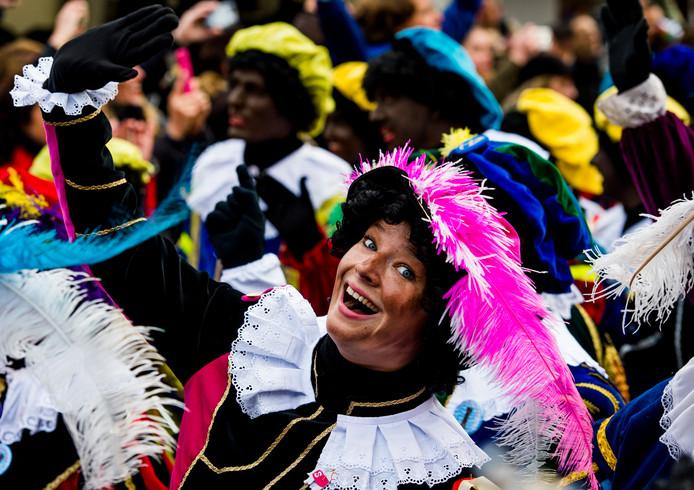
Zwarte Pieten – Черные Питы – это помощники Синтерклааса. В последние годы они стали головной болью для политиков. Вся проблема – в их черноте и в ее интерпретациях.
По мнению одних, они черные потому что вымазались в саже, пока доставляли детям подарки через дымоходы.
Но эта версия не выдерживает критики по мнению других, кто обращает внимание на их полные губы и кудрявые волосы – явные отсылки к их расовой принадлежности.
Целому ряду взрослых, не только с темным цветом кожи, но и присоединившимся к ним белокожим, наличие Черного Пита напоминает о рабстве, о голландских судах, перевозивших чернокожих рабов, о том, что черные прислуживали белым, как Черные Питы Синтерклаасу. Каждый год этот праздник сопровождался демонстрациями протеста и дискуссиями. С 2019 года был найден компромисс: Питов повсюду перестали красить в черный цвет. Тон задал Sinterklaasjournaal, который каждый год освещает путь и прибытие корабля Синтерклааса. Но противникам Черных Питов этого было недостаточно, они настаивали на том, чтобы Питов переименовали или ликвидировали.
С 2020 года Черные Питы превратились просто в Питов. Они могут быть измазаны сажей, но не полностью. Любые ассоциации с чернокожими, как то – кудрявые волосы и полные губы – ушли.
Прибытие (intocht) Синтерклааса в 2022 году
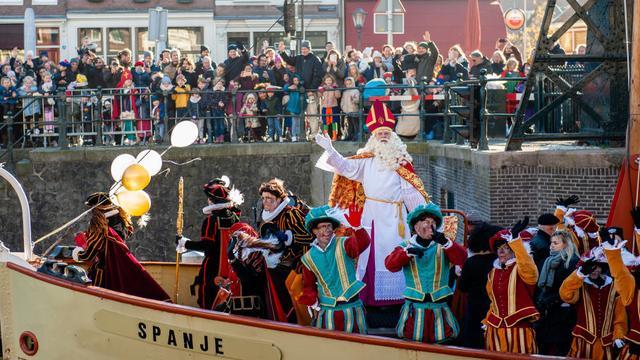
- Синтерклаас приплывает на своем корабле вместе с Питами. Питы веселят детей и раздают печеньки – pepernootjes.
- На прибытие Синтерклааса принято приходить с детьми, наряженными в костюмы Питов.
- Есть “главный” Синтерклаас. О его прибытии рассказывает по телевизору детский Sinterklaasjournaal
- Есть местные Синтерклаасы. Куда именно они приплывут в ваших краях – об этом можете узнать у других родителей или погуглить:

Что происходит после прибытия Синтерклааса и до Вечера подарков
С момента прибытия и до Вечера подарков (Pakjesavond) происходит следующее:
- По легенде, каждую ночь Питы и конь Синтерклааса работают: разносят детям подарки. Делается это через трубу дымохода.
- Поэтому принято каждый вечер (у камина или у входной двери) ставить ботинок, а в него класть лакомство для коня, например, морковку.
- Утром морковка исчезает, а вместо нее каждое утро до 5 декабря дети обнаруживают что-то недорогое, по мелочи, те же сладости или игрушки.
- Все это поддерживает огонек счастливого ожидания до Вечера подарков.
Традиционные сладости для Sinterklaasfeest:
Chocoladeletter (первая буква имени, сделанная из шоколада)
Рepernoten – пепернотен – сладость с медом и анисом
Кruidnoten – кряуднотен – на вид как пепернотен, но с корицей, имбирем, кардамоном и без аниса
Speculaasjes – спекуласьес – печенье с теми же пряностями, что и в кряуднотен
Marcepein – марципяйн – сладости из марципана

Синтерклаасфейст (Sinterklaasfeest) и Вечер подарков (Pakjesavond)
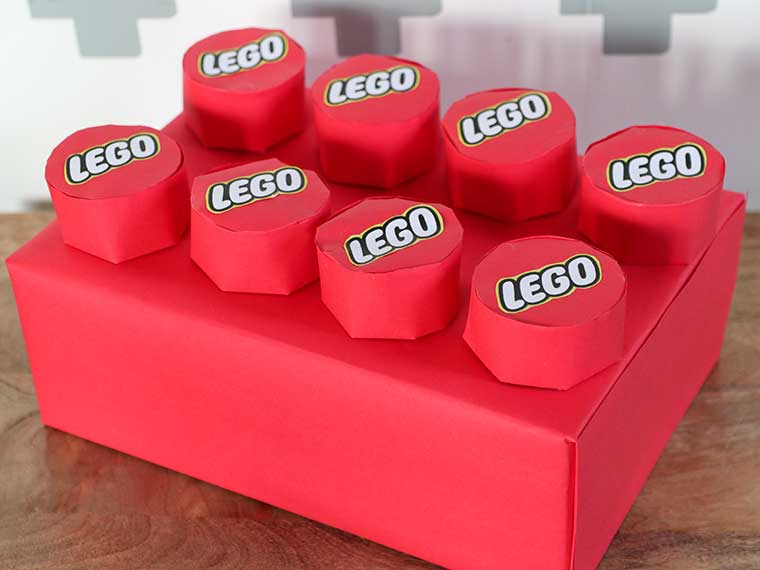
Есть две вариации праздника:
Одна – для маленьких детей, которые верят в Синтерклааса: 5 декабря вечером Синтерклаас со своими помощниками приносит большой мешок подарков, кладет их у дверей и исчезает.
Другая – для всей семьи, и верить в Синтерклааса необязательно. Члены семьи делают друг другу сюрпризы. Кто кому – это решает лотерея.
В сюрпризе (surprise) главное – не сам подарок – он может быть чисто символическим – а креативная упаковка, сделанная своими руками. Упаковка должна иметь отношение к увлечениям, хобби, мечтам, целям того, кому дарят сюрприз. К примеру:
- Футболисту – футбольное поле
- Любителю мультиков – Спончбоб или Минион
- Любителю путешествий – чемодан или глобус
В общем, для фантазии нет пределов!
Вот здесь вы можете почерпнуть вдохновение, чтобы сделать настоящий шедевр из вашей упаковки. Дети обожают креативные упаковки, не выбрасывают их и бережно хранят, иногда до следующего Пакьесавонда.
К сюрпризу прилагается шутливый стишок о получателе подарка (gedichtje). Тематика – как прошел год, молодец получатель или не очень, достоин ли он подарков. Для тех, кто сомневается в своем поэтическом даре, в интернете есть множество сайтов-помощников. Заводишь туда данные получателя, получаешь целую поэму.
Вот один из таких генераторов стихов
После распаковки подарков праздник не заканчивается. Вечер посвящен семейному времяпрепровождению, например, настольным играм.
Как Синтерклаасфеейст отмечают в начальных школах
Может случиться так, что этот праздник вовсе не отмечают, если школа не католическая, не протестантская, а общедоступная. Если же отмечают, то в школе в младших группах смотрят Sinterklaasjournaal, организуют торжественное прибытие Синтерклааса в школу и изготовление сюрпризов друг другу.
Это прекрасная традиция, и начинается она с того, что дети участвуют в лотерее. На лоте написано имя того, кому нужно будет сделать подарок и стишок. У детей и родителей есть несколько недель, чтобы подготовиться.
Изготовитель сюрприза получает краткий набор сведений о том, кому он делает сюрприз: хобби, увлечения, вкусовые предпочтения. Как правило, заранее оговаривается сумма стоимости подарка, одинаковая для всех. И это буквально несколько евро – в подарке важна не цена, а внимание.
Да, кстати, многие учителя стараются сделать так, чтобы младшие дети, верящие в Синтерклааса, не пострадали от циничных старших, которые так и норовят злорадно сообщить, что Синтерклаас не существует. Родителям высылаются мейлы и вотсапы с просьбами провести со старшими детьми разъяснительные беседы на этоу тему.
Sinterklaasjournaal -“новостная” телепрограмма
Выходит на телеканале NPO3 (Zapp), 18:00 каждый день с середины ноября до 5 декабря.
Синтерклаасжурнал – это отдельное явление. Его придумали в 2001 году, и с тех пор у него бессменная ведущая Dieuwertje Blok (аналог Тети Вали в передаче “В гостях у сказки”) и захватывающий детское воображение сюжет, призванный создать предпраздничный ажиотаж: репортаж о том что происходит с Синтерклаасом и Питами на корабле. Каждый год происходит что-то особенное. То подарки пропадут по дороге, то еще что-то. В 2019 конь Америго ушел на пенсию и его сменил конь по имени Ozosnel (О-Такой-Быстрый). Также Синтерклаас и команда не плыли на корабле, а ехали на паровозе. Синтерклаасжурнал преподносится как новости, например, берутся интервью у чиновников, которые готовятся к прибытию, что очень помогает поддерживать детскую веру в Синтерклааса.
Все выпуски журнала и много чего другого интересного – здесь
Как получить от Синтерклааса видеосообщение
Как созвониться с Синтерклаасом
Android app
Apple Store
Еще пара сногсшибательных фактов
Теперь вы знаете о Синтерклаасе все. Ну почти все.
Есть еще пара фактов из серии “не спрашивайте, почему”. Они взорвут вам мозг, но и будут прекрасным поводом для веселого small talk.
Как зовут коня Синтерклааса в Бельгии?
Белый конь Синтерклааса, который в Нидерландах зовется Ozosnel, в Бельгии зовется Slecht Weer Vandaag (Сегодня Плохая Погода)
Что значит слово kapoentje в самой популярной песне о Синтерклаасе?
У слова kapoentje – несколько переводов.
Основные из них – кастрированный петух, негодник, проказник.
Вам наверняка будет интересно почитать про другого любимого детьми героя праздников, книг и песенок. Это Синт Мартин.
5 декабря, когда наступает ночь, в Нидерланды приезжает Синтерклаас. Пока все хорошие мальчики и девочки спят, голландский Санта-Клаус пробирается в их дома и оставляет там угощения и подарки, которые дети находят следующим утром.
Но День Синтерклааса – это не то же самое, что Рождество, и его празднуют несколько иначе. Конечно, в этот день весёлый старик так же, как и везде, дарит подарки, но есть масса мелких деталей, которые сильно отличают его от всех остальных – и, как вы скоро узнаете, они могут быть очень необычными.
Приготовьтесь к историям о Синтерклаасе – в комплекте с африканскими рабами, похищениями детей, кастрированными священниками и так далее. Сегодня мы познакомимся со странным, волшебным и, возможно, немного расистским праздником в Нидерландах.
10. Синтерклаас, кастрированный петух
Синтерклаас выглядит страшнее Санта-Клауса, хотя и похож на него: это весёлый старик с белой бородой и в красном халате. Кроме того, у него есть митра и посох епископа, но нет миссис Синтерклаас. И дело не в том, что он сейчас без жены – дело в том, что её никогда и не будет.
Это не просто мелкая деталь. Существуют праздничные песенки, которые полностью посвящены девственности Синтерклааса, например: «Синтерклаас капоентье» («Синтерклаас, ты кастрированный петух!»).
И эта песня – не мелочь, а очень важная деталь праздника. Вспомните сцену из фильма «Чудо на 34-й улице», где маленькая голландская девочка поёт песенку в ожидании Санта-Клауса.Так вот, это та самая песня о Синтерклаасе, в которой говорится, что он – кастрированная домашняя птица.
Эта песня настолько древняя, что никто не знает, почему старика называют петухом, но это почти наверняка связано с его обетом целомудрия. Большинство людей предпочитает не говорить об этом, поэтому в английской версии слова чуть изменили и стали петь: «Синтерклаас, маленький шельмец». Но это не соответствует истине.
Насколько нам известно, смысл песни может быть буквальным. Она может напоминать о старой традиции, когда пели рождественские песенки. Скорее всего, Синтерклаас пел их не глубоким и весёлым тенором, а исполнял высоким сопрано, свойственным кастратам.
9. Африканец Чёрный Пит, раб Синтерклааса
Синтерклаас приходит не только к детям, и у него есть помощники. Однако это вовсе не компания весёлых остроухих эльфов. Это африканские рабы, и их всех зовут Чёрными Питами.
Официально предполагается, что Чёрный Пит должен быть мавром из Испании, но очень редко бывает, чтобы эту роль играл настоящий мавр. Как правило, вместо мавра эту роль исполняет какой-нибудь белый голландец, раскрашенный чёрной краской, в комплекте с мультяшными красными губами и париком из курчавых чёрных волос. И он говорит не как мавр, а с акцентом африканского раба из Суринама, бывшей голландской колонии.
Помощник Синтерклааса Чёрный Пит – это недалёкий плут и мошенник, и он немного страшен. Он проникает в дома и бьёт плохих детей ручкой от метлы. С течением времени его образ стал меняться. Сейчас уже некоторые голландцы пытаются его представить как белого, но очень грязного человека, который остро нуждается в помывке.
8. Изначально в помощниках у Синтерклааса ходил Сатана
Вам может показаться, что от идеи с Чёрным Питом немного отдаёт расизмом, но он всё же лучше, чем первоначальный помощник Синтерклааса. В Средние века, когда Синтерклаас отправлялся навещать детей в их домах, он брал с собой другого помощника: Сатану, Принца тьмы.
Детали этой истории немного расплывчаты. Единственное, что мы знаем точно – так это то, что в Средние века голландцы очень любили рисунки, на которых Синтерклаас тащит за собою Сатану на цепи. Об этом мало написано, поэтому мы не можем ответить на этот насущный вопрос, который так и вертится на языке: с чего Синтерклаас вдруг решил, что, отправляясь в гости к детям, было бы неплохо притащить с собой и Сатану?
Но, похоже, что история с Чёрным Питом берёт своё начало отсюда. Спустя какое-то время люди решили, что не совсем удобно рассказывать своим детям, что к ним придёт Сатана, поэтому его заменили на чернокожего раба. Конечно, это тоже не совсем политкорректно, но раньше на это не обращали внимания.
7. Синтерклаас живёт в Испании
Синтерклаас живёт вовсе не в каком-нибудь экзотическом месте, вроде Северного полюса, а в обычной Испании. И он прибывает в Нидерланды не на летающих салазках, а на чартерном пароходе.
Трудно сказать, почему Синтерклаас, прообразом которого был живший в Турции Св. Николай, должен прибыть из Испании, но вероятно, что здесь наложились друг на друга несколько запутанных историй. Первоначально Синтерклаас был голландцем. Потом кто-то написал песню о том, что он едет в Испанию за апельсинами. Поэт-песенник на самом деле не знал, что такое апельсины, поэтому он их назвал «оранжевыми яблоками». Вопрос об этих яблоках настолько всех запутал, что вскоре все забыли, что Синтерклаас собирался лишь посетить Испанию, а не жить в ней. В итоге Испания стала его домом.
В любом случае, сегодня он приезжает на корабле. Все дети его с нетерпением ждут, а его чёрные рабы облепливают всё побережье Амстердама. Затем они следуют за ним, пока он катается на лошади по городу, заставляя своих рабов разбрасывать маленьким детям печенье.
6. Родители оставляют Чёрному Питу бутылки с пивом
5 декабря дети готовятся к тому волшебному моменту, когда Синтерклаас и его Чёрные Питы прокрадутся к ним в дома и оставят свои подарки. И поэтому, дожидаясь их прибытия, дети оставляют свои ботинки возле камина, чтобы было ясно, куда эти подарки нужно складывать.
Праздник – это больше отдача, чем получение, и поэтому дети тоже дарят свои маленькие подарки Синтерклаасу и его друзьям. Для Синтерклааса они оставляют кофе и стихи. Для его лошади – сено и морковь. А для Чёрного Пита они кладут в ботинок пару бутылок пива.
Как выясняется, Чёрный Пит – любитель крепкого алкоголя. Это настолько важная часть его образа, что в Нидерландах существует несколько сезонных сортов пива «Чёрный Пит». Всё это тёмные эли, на этикетках которых часто присутствует смуглый мужчина на чёрном фоне.
5. Чёрный Пит сажает детей в тряпичный мешок
Но не все дети в День Синтерклааса получат подарки. Если они себя плохо ведут, родители показывают детям записки от Синтерклааса, в которых он предупреждает, что нужно исправиться. Иначе, когда наступит 5 декабря, ребёнка ждут большие неприятности.
Когда Чёрный Пит пробирается в дом, он приносит с собой большой мешок и ручку от метлы. Его задача состоит в том, чтобы выследить всех тех детей, которые себя плохо ведут, бросить их в мешок, побить их ручкой метлы, а затем утащить в Испанию. Что он там с ними делает, никто не знает, так как никто из детей ещё не возвращался.
Конечно, родители не избивают своих детей и не отправляют их в Испанию, но они могут оставить детей с «плохими подарками». Если ребёнок плохо себя ведёт, он может найти в своей обувке ручку от метлы – как напоминание о том, какая его ждёт судьба. Взрослым нравится воспитывать детей через психологический террор.
4. Чёрный Пит – не волшебник, он просто умеет пробираться в чужие дома
Когда Синтерклаас навещает детей, у него нет ни волшебного северного оленя, ни сверхъестественных способностей, которые помогли бы ему доставить игрушки каждому мальчику и девочке по всей стране. У него есть только один инструмент: большая толпа рабов.
За доставку подарков в дом обычно отвечают Чёрные Питы, и они это делают путём тайного проникновения. Традиционно считается, что Чёрный Пит забирается на крышу дома по стене, в то время как Синтерклаас катается рядом на лошади. Затем Чёрный Пит спускается по дымовой трубе и начинает осматривать оставленные вещи в поисках выпивки.
С помощью Чёрного Пита Синтерклаас узнаёт, послушные ли дети живут в этом доме. Забравшийся на крышу Чёрный Пит подслушивает, что делает ребёнок, а затем говорит Синтерклаасу, заслуживают ли дети подарка или мешка.
3. Родители нанимают профессионалов, чтобы обмануть своих детей
Во всём мире родители обманывают своих детей и говорят им, что Санта-Клаус настоящий. Но голландцы заходят немного дальше. Они нанимают актёров.
В Нидерландах есть целая гильдия профессиональных исполнителей роли Чёрного Пита, и вы можете нанять их, чтобы они посетили ваш дом. Это довольно большая организация. В Амстердаме официально зарегистрировано более 600 Чёрных Питов.
5 декабря родители нередко нанимают актёров, чтобы они пришли к ним домой. Если же у родителей нет денег, то они просят об этой услуге соседей. Когда дети готовятся лечь спать, Чёрный Пит стучит в дверь, оставляет подарки, а затем убегает. Дети видят, как помощник Синтерклааса растворяется в ночи.
Детям нетрудно поверить, что Синтерклаас реально существует, потому что на все вопросы типа «А как Санта доставляет все эти подарки за одну ночь?», существует очень убедительный ответ. У него есть огромная сеть бесплатно работающих рабов. Дети даже могут увидеть их сами.
2. Синтерклаас пишет детям насмешливые стихи
Подарки – это не единственное, что оставляет Синтерклаас. В качестве забавного маленького бонуса в Нидерландах он оставляет ребёнку и кое-что ещё: стихотворение-дразнилку.
Они похожи на пародию. В День Синтерклааса люди дарят друг другу маленькие четверостишия, высмеивающие вредные привычки или недостатки характера друг друга. Они могут высмеивать хвастливость или неуспеваемость ребёнка по грамматике. Родители пишут стихи для своих детей и подписывают их «Синтерклаас», чтобы дети подумали, что Синтерклаасу надоели их глупости. 5 декабря эти стихи будут лежать рядом с шоколадом и подарками; это крошечное письмо от мифического существа позволяет им узнать о своих недостатках.
1. А в Люксембурге – ещё хуже
Каким бы странным не показался День Синтерклааса в Нидерландах, в Люксембурге дела обстоят ещё хуже. Там людей тоже посещает Синтерклаас, но он не приводит с собой в Люксембург Чёрных Питов. Вместо них он является в компании с Хаускером, и последний выглядит совершенно ужасно.
Вместо того чтобы одеться в яркие, весёлые цвета, как это делают Чёрные Питы, Хаускер носит чёрные рваные одежды, в которых он выглядит как умирающий нищий или сама смерть. У него нет с собой печенья и подарков для хороших детей, зато всегда есть палка и крутой нрав.
Вся его роль – избиение детей. Хаускер не дарит подарков и не марширует на парадах – он просто бьёт детей палкой. На этом его обязанности кончаются. В Люксембурге дети ведут себя хорошо в надежде, что Хаускер оставит их в покое.
Источник
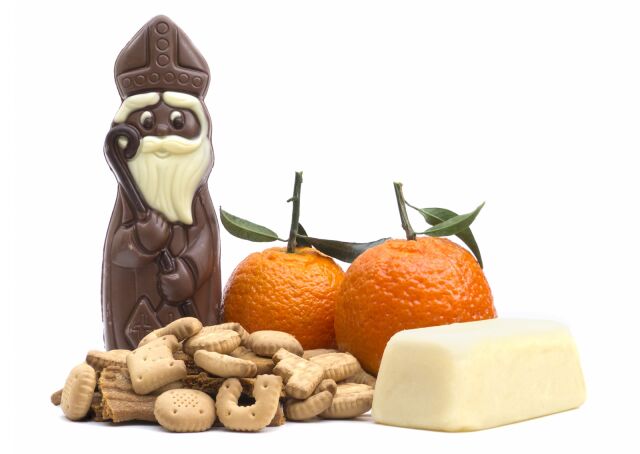
Больше всего День святого Николая (Sinterklaasavond), который ежегодно отмечается 6 декабря, любят голландские дети. Вечером 5 декабря люди анонимно дарят друг другу красиво упакованные подарки.
По сведениям «голландской мифологии», Синта — Синтерклаас — святой Николай — является близким родственником Санта-Клауса. В прошлом голландцы перенесли в Америку многие свои обычаи, которые за прошедшее время изрядно трансформировались. Выходцы из Нидерландов, переселившиеся в 17 веке в Нью-Амстердам (будущий Нью-Йорк) в Америке, «забрали» с собой популярного святого Николая, защитника от всяких невзгод. Святой «прижился» на новой родине и трансформировался со временем, вобрав в себя элементы различных культур, в Санта-Клауса.
Сам святой Николай как историческая фигура родился в 3 веке нашей эры на территории современной Турции и был епископом города Миры. Все свое богатство, доставшееся в наследство от родителей, он раздал бедным. Был очень любим народом, в особенности детьми, для которых творил настоящие чудеса. Епископ умер 6 декабря 342 года, а в 1089 году его останки были перевезены в Италию. С тех пор 6 декабря считается его праздником и праздником детей.
По народным голландским поверьям, Санта-Клаус — это святой покровитель с белой бородой, который приезжает из Испании (почему именно из Испании — никто не знает). Компанию ему составляют слуги, которых называют Черные Питы (Zwarte Pieten). Черный Пит одет как средневековый паж, на голове у него шляпа с пером. В наше время принято считать, что кроме них еще существуют Синие и Зеленые Питы.
Гости прибывают в Нидерланды 6 декабря с моря, через Роттердам, а встречают их в крошечной рыбацкой деревушке Монникэндам, расположенной недалеко от столицы, не только горожане, но и власти.
Вместе с главными героями на пристань спускается многочисленная свита. Их приветствуют выстрелами, салютом, звоном колоколов на ратуше. На набережной их встречают самые настоящие члены городского правления — бургомистр, альдермен, иные должностные лица. Святому подводят белого коня, он умело поднимается в седло, и процессия движется через весь город. Слуги-мавры придают процессии особый колорит — все они, кроме черного Пита, одеты в «сверхсовременные» костюмы и гордо восседают на трескучих мопедах. В день прибытия процессия движется по главной улице города, затем начинает посещать детские учреждения.
Ближе к Рождеству Клаус и Пит появляются и в частных домах. Когда приближается час прихода Санты, родители стараются занять чем-нибудь детей, оставив их в гостиной. Дверь приоткрывается, и в нее просовывается черная рука, которая разбрасывает сладости и фрукты. Пока дети их собирают, важно входит святой Николай. Он расспрашивает детей об их успехах и поведении, и при этом, как настоящий святой, уже все про них знает. Он дает оценку поведению и поступкам детей, произносит наставление и уходит.
Марина Добрынина
Путешественница и спортсменка. Меня можно увидеть либо на соревнованиях по бегу, либо в каком-нибудь очередном городе с фотоаппаратом в руках. Посетила больше 20 стран и не собираюсь останавливаться на достигнутом.
Синтерклаас, Черные Питы и печеньки или почему стоит попасть в Нидерланды до 5 декабря?
Ноябрь близится к своему логическому завершению и многие магазины, кафе и рестораны Москвы начали украшать свои витрины еловыми ветками, мишурой, хрустальными шарами и яркими лампочками. В Европе тоже вовсю готовятся к Рождеству и Новому году. И если вы хотите посмотреть и отметить эти праздники за границей, я бы рекомендовала поехать в Нидерланды. Голландцы опять выделились на фоне остальных европейцев, поэтому Рождество и Санта-Клаус у них «не как у всех».
Дело в том, что голландского Санта-Клауса зовут Синтерклаас, передвигается он не на оленях, а приплывает на корабле из Испании и помогают ему не эльфы или гномы, а Чёрные Питы (по-голландски — Zwarte Piet) – такие смешно одетые дети и взрослые, в разноцветных шортах и пиджаках с вымазанным черной краской лицом и руками.
Согласно голландской традиции, ежегодно в Нидерландах выбирают один город, куда с официальным визитом приплывает Синтерклаас. Обычно это происходит в субботу в середине ноября. В прошлом году первым городом на длинном пути доброго бородатого дядьки была Гауда. В этом году официальный приезд Синтерклааса и его помощников состоялся 18 ноября, в 12.00 в городе Доккюм (Dokkum) в провинции Фрисландия. По традиции, на следующий день, Синтерклаас и Чёрные Питы поедут в другие города, в том числе в Амстердам, общаться с детьми и дарить им подарки. Они будут трудиться почти 3 недели — вплоть до 5 декабря, поощряя хороших деток и наказывая березовым прутом тех, кто вел себя плохо.
Как узнать — кто вел себя хорошо, а кто не очень? Для этого Синта (как ласково его называют голландцы) ведет учёт в своей большой книге, где записаны имена всех детишек, а также полагающиеся им подарки. 5 декабря состоится «судный день» и тогда-то мы и узнаем, кто и как отличился в этом году.
Наблюдая приезд, точнее приплытие Синтерклааса и весь ажиотаж вокруг него, у меня возникло множество вопросов. Например, почему его помощников зовут Чёрными Питам? И почему у них лица в черной краске? Почему Синта приплыл на корабле, да еще из Испании? Зачем ему белый конь? Если вам это тоже интересно, давайте разбираться.
Начну с Чёрных Питов – на их счет есть несколько версий. По одной из них, когда-то давно Синтерклаас спас от смерти одного маленького негритенка и тот в благодарность стал ему помогать. По другой версии, помощники приносят подарки детям через дымоход и так пачкаются сажей, что становится такого насыщенно черного цвета. Какая из версий правильная – сейчас понять уже сложно, но, чтобы отдать дань традициям, современные голландцы щедро мажут свои щеки, лоб и кисти рук черной краской, напоминая Майкла Джексона в молодости.
Забавно, но в Чёрных Питов на праздник переодеваются исключительно «белые» люди. Я ни разу еще не видела ни одного в костюме Пита. То ли сами не хотят, то ли белые из соображения политкорректности им не дают так наряжаться. Но выглядит это действительно странно и нелепо.
Время от времени голландцы устраивают демонстрации с антирасистскими лозунгами и требуют запретить Питов, потому что они напоминают о рабском прошлом и жестокой эксплуатацией афроамериканцев. Говорят, помощников Синты хотели переименовать то ли в Цветочных Питов, то ли Разноцветных. Была даже шальная идея называть их Сырными – особенно активно об этом говорили, когда Синта начинал свой тур по стране в Гауде – сырной столице Нидерландов. Но, по-моему, в своей толерантности и боязни обидеть чувства других голландцы перегибают палку, и как Питов не называй, лица-то у них все равно в чёрной краске.
Помимо Чёрных Питов, у Синтерклааса есть белый конь по кличке Америго. Именно на нем Синта разъезжает по стране и развозит подарки. Иногда дети и родители идут на хитрость и у дома кладут пучки морковки или ведро воды, чтобы приманить Америго, а вместе с ним и Синту. Я, кстати, у одного из полицейских на площади видела морковку в петлице. Наверное, он тоже ждет подарка он доброго дедушки.
Пока Синта едет на своем коне, играет оркестр, а Чёрные Питы достают из своих белых мешков имбирное печенье “pepernootjes” и раздают детям. Его, кстати, выпекают по особому рецепту. Сейчас во всех магазинах Нидерландов на самых видных местах лежат пачки с этим печеньем. По виду, если честно, они мне напоминают сухой корм для собак.
Еще один важный вопрос, который меня терзал: Синтерклаас и Санта-Клаус — это один и тот же персонаж? Однозначно ответить на него сложно. Одни источники пишут, что это два совершенно разных человека. Синта живет в Испании, загорает на курортах, а в Нидерланды и соседнюю Бельгию приезжает только в ноябре-декабре. Санта-Клаус живет в Лапландии (или на Северном полюсе, споры еще идут) и прилетает на оленях со своими помощниками-эльфами 25 декабря.
Совершенно точно могу сказать одно – одежда у Санты и Синты точно разная. На голове у Синтерклааса митра, носит он красную мантию, под которой прячется кружевная ряса, на ногах черные ботинки, на руках длинные белые или фиолетовые перчатки, в руке — посох. То есть всем своим видом Синта больше напоминает епископа. Санта-Клаус, как вы помните, одет попроще – красные штаны и тулуп, колпак, черные ботинки.
Откуда появился Санта-Клаус? Его прообразом является христианский святой Николай Чудотворец (Санта — «святой», Клаус — «Николай»). Родился Святой Николай в Малой Азии в III веке н.э., покровительствовал морякам и помогал бедным девушкам собрать денег на приданое. Говорят, что кошельки с деньгами он как раз через дымоход закидывал, чтобы сохранить анонимность. Однажды кошелек так метко попал в сушившийся на огне носок, и так это всем понравилось, что появилась традиция — упаковывать подарки именно в чулочно-носочную продукцию. Умер Святой Николай 6 декабря, поэтому дарят подарки в ночь с 5 на 6 число в знак почитания святого. Надо ли говорить, что имя святого Николая по-голландски звучит как Синтерклаас (Sinterklaas, также Sint Nicolaas)?
В период Реформации (XVI-XVII века) в Европе стали довольно прохладно относиться к святым, поэтому вместо святого Николая подарки стал дарить младенец Иисус Христос. «Подарочный день» был перенесён с 5 на 24 декабря, то есть на время рождественских ярмарок. Спустя пару веков европейцы опять передумали, и снова подарки детям стал приносить святой Николай. Однако теперь это происходило уже в конце декабря, на Рождество. Но хитрые голландцы решили, что дети – цветы жизни, и им для них ничего не жалко, поэтому счастливчики могут получать подарки и на 5 декабря, и на Рождество.
Но все-таки главный новогодний праздник в Нидерландах – это 5 декабря. Именно Синтерклаас сейчас волнует воображение всех детей, для него они учат песенки и стихотворения, по телевизору идут про него передачи, а родители заготавливают морковку для его верного белого коня Америго.
Я тоже жду 5 декабря. Вдруг и ко мне придет Синта? Я была хорошей девочкой в этом году!
Синтаклаас с Черными Питами… кто же это?
Знаменитый Санта Клаус на бельгийских и нидерландских берегах известен под совершенно другим именем — Синтаклаас или Синтерклаас.
Жители этих двух стран с замиранием сердца ждут последних чисел ноября, ведь именно тогда начинается яркий, полный радостных эмоций фестиваль, знаменующий собой старт зимнего праздничного сезона во всей стране.
Синтаклаас — кто он и как появился?
Немногие американцы знают о том, что их старый-добрый Санта Клаус — всего лишь с голливудским размахом пропиаренный персонаж, основанный именно на Синтаклаасе. В США в свое время решили, что для зимних праздников им нужно что-то поинтереснее, чем английский Father Christmas и почти ничего не оставили от первоначальной истории. На самом деле Синтаклаас родом совсем не с Северного полюса, а, как ни странно, — с юга.
Согласно древним легендам, образ голландского Деда Мороза сложился из византийского архиепископа — Николая Мирликийского (IV век н.э.). Да-да, того самого Святого Николая. Среди верующих он снискал большое уважение своими благими делами, и его стали сопоставлять с персонажем, дарующим приятные подарки в ночь перед священным христианским праздником — Рождеством.
Казус истории
Уже не один год активно обсуждается один момент, который превратился в сплошной конфуз. Дело в том, что помощников Синтаклааса зовут Черными Питами, что связано непосредственно с цветом их кожи. В общем-то, это вполне логично, ведь долгое время считалось, что Питы приплывают с Синтаклаасом на корабле из солнечной Испании, где в то время было немало мавров, которые, как известно, чернокожие (предположительно рабы).
Сейчас же историю немного подкорректировали, связав черные лица Питов с их привычкой залезать в дома через дымоходные трубы в поисках детских ботинок. Поэтому их лица теперь не закрашивают черным гримом полностью, а делают подобие следов от сажи.
Невероятный накал страстей или за неделю до…
Где-то за неделю непосредственно до начала радостного торжества на одном из каналов для детей начинается «новостная» (но для голландцев она таковая в прямом смысле слова) передача, в реальном времени информирующая о передвижении Синтаклааса со своими помощниками сквозь непогоду и различные опасности. Вся малышня страны с замиранием сердца дожидается персонажа, который привезет с собой радость и, конечно же, подарки.
Каждый год Синтерклаас начинает проведение торжества с разного города страны. Занимательно, что о передвижении праздничного кортежа можно узнать наперед. В столице вообще легко выбрать себе место, где можно будет спокойно лицезреть любимого Синтаклааса (гугл-карты в помощь).
Те, кто хочет быть в числе первых людей, встречающих Синтаклааса, сходящего с корабля или сверкающего на своем белоснежном коне (Америго) в сопровождении помощников, отправляются к берегам Амстела и его каналам или же выстраиваются вдоль центральных улиц города.
Ботинки — на камин!
Маленькие жители Нидерландов искренне верят в Синтаклааса, поэтому готовятся к зимнему празднику особенно тщательно. Ребята ставят свои лучшие ботинки на камин или снаружи дома у входной двери (если нет камина) не один раз в течение той недели, когда Синтаклаас гостит в их городе. В обувь кладут записки для него и морковку для его верного Америго. Обязательно нужно спеть призывную песенку, чтобы Черные Питы ее услышали и пробрались в дом через дымовую трубу. Они забирают детские послания для Синтаклааса, а приносят подарки.
Многие в Нидерландах верят в то, что Синтаклаас настоящий и это неудивительно, ведь он далек от таких «коммерческих проектов» как Санта Клаус и даже наш Дед Мороз. Голландский хранитель зимнего праздника не ходит по детским утренникам и не сидит в торговых центрах, фотографируясь с малышами. Он ездит по стране, создавая атмосферу праздника для всех детишек и находя время навещать тех из них, кто нуждается в поддержке больше всего (в детдомах и больницах).

